A team from ASU is bringing hope to families impacted by autism and Pitt-Hopkins syndrome


A team from ASU is bringing hope to families impacted by autism and Pitt-Hopkins syndrome


Contributors
Beverly Johnson
ASU’s associate director of career readiness, she is an alum who graduated in 2021 with a master’s degree in communication. She does 1:1 student advising, manages the Career Services team and develops career content.
Amanda Loudin
A health journalist, her work has appeared in
The New York Times, The Washington Post, Harvard Medicine and other national media outlets.
Jeff Newton
An editorial and commercial photographer, his clients include Google, adidas Originals, The New York Times, Sports Illustrated, Men’s Journal, Popular Science, Forbes, Entrepreneur, Banner Health and Cold Stone Creamery.
Kristin Toussaint
The staff editor of the Impact section at Fast Company, she was previously a senior news reporter at Metro in New York City.
Dakota Webber
The assistant director of career readiness at ASU’ s West campus for Career Services, she is an ASU alum, ’20 MEd in higher and postsecondary education.
The official publication of Arizona State University
Fall 2023, Vol. 26, No. 4
CHIEF BRAND OFFICER, PUBLISHER
Jill Andrews �97 BS, �03 MPA
MANAGING DIRECTOR, EDITOR
Lindsay Kinkade
MANAGING EDITOR
Kari Redfield
SENIOR ART DIRECTOR
Heidi Easudes
DIRECTOR, ASU NEWS
Penny Walker
DEPARTMENT EDITOR, COPY EDITOR
Leigh Farr
PHOTO COORDINATOR
Sabira Madady
DESIGNERS
Erica Brooks, Maggie Conners, Beatrice Guo, Tamara Kopper, Mark Munoz
PRODUCTION
Chris Myers, Jason Puckett
If you would like to update your mailing address or switch to the digital version: news.asu.edu/content/subscribe
STORY IDEAS AND ADVERTISING INQUIRIES asuthrive@asu.edu
ASU THRIVE MAGAZINE PO Box 875011, Tempe AZ 85287-5011 602-543-5234 asuthrive@asu.edu news.asu.edu/thrive-magazine
ASU Thrive (USPS 024-438; ISSN 1940-2929) is published quarterly by Arizona State University Enterprise Brand Strategy and Management, PO Box 875011, Tempe, AZ 85287-5011, 480-727-5440. Subscriptions are sent to all ASU alumni. For detailed information about supporting alumni traditions, scholarships and programs, visit alumni.asu.edu/give-back/donate Periodicals postage is paid at Tempe, Arizona, and additional mailing offices. Postmaster: Please send address changes to ASU Thrive, Attention: Circulation, PO Box 875011, Tempe, AZ 85287-5011. Permissions: Portions of this publication may be reprinted with the written permission and proper attribution by contacting the ASU Thrive editor. ASU Thrive can be accessed online at news.asu.edu/ thrive-magazine
A few months ago, the university announced bold plans for ASU Health, a far-reaching transuniversity effort with our partners in the Valley and across the nation. It is an important new initiative to improve Arizona’s health outcomes.
This unprecedented effort to create a “learning health ecosystem” will accelerate and focus the university’s healthrelated efforts to tackle our state’s most pressing challenges. It includes the creation of two innovative first-in-the-nation schools: the School of Medicine and Advanced Medical Engineering and the School of Public Health Technology — as well as a vision for ASU Clinics to provide community care and serve as a hub for experiential learning and clinical research.
In addition, we will address critical shortages in nursing and other health professions through focused accelerated growth in the Edson College of Nursing and Health Innovation and in the College of Health Solutions. Through our Learning Enterprise, the university will offer robust programs in health professional upskilling and interprofessional training.
We have a critical opportunity to address Arizona’s significant and growing health care needs and to develop new and effective solutions. ASU has the imagination, experience and will to do it. Over the past 20 years, the university has shown that we know how to create transformative change at scale for our local community, nation and world.
You can read about a handful of our latest medical innovations in this issue, including the first-ever human trial and treatment for a rare disease called Pitt-Hopkins syndrome, which shows that a healthy biome reduces gastrointestinal symptoms in individuals with both Pitt-Hopkins and autism. You will learn about a tissue-on-a-chip to help revolutionize cancer treatment, the first walking and sweating manikin for health research and more about our work with Mayo Clinic.
As we build ASU Health, we will continue to connect community needs to our programs and outcomes, supporting the health and wellness of everyone in Arizona.
Michael M. Crow President, Arizona State University twitter michaelcrow linkedin michaelmcrow INSTAGRAM asuprescrow FACEBOOK presidentcrowthat will benefit from an ASU treatment.
A team from ASU is bringing hope to families impacted by autism and Pitt-Hopkins syndrome. 26

High-fiber whole foods improve gut health. 34
Moving toward cancer cures: Researchers hone in on how tumors grow to create personalized medicine. 35
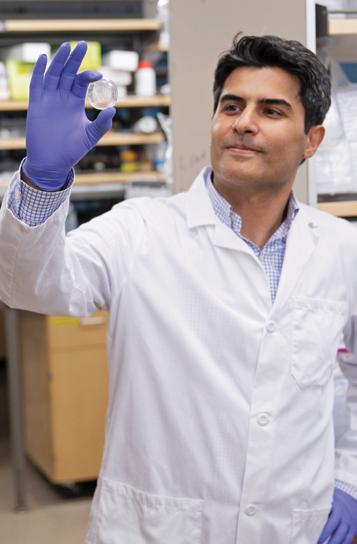
Students gain experience as part of ASU, Mayo Clinic programs. 38
World’s 1st outdoor sweating, breathing and walking manikin for health. 40


ASU’s West campus commemorates
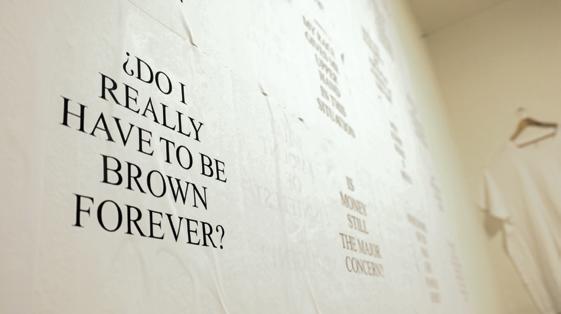
Double Ten Day with authentic Taiwanese food, music, arts and culture, culminating in a spectacular fireworks display.

Saturday, Oct. 7, 6–8:30 p.m., Sun Devil Fitness Center lawn destinationwest.asu.edu

Free Family Oct.
Scott Jeffers and his band perform using traditional instruments and a symphony of music melded from discoveries Jeffers made during his global travels. Journey the world through music that blends sounds from international cultures.
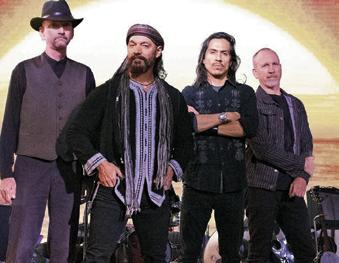
Saturday, Oct. 21, 7:30 p.m., ASU Kerr, 6110 N. Scottsdale Road, Scottsdale asukerr.com
Ticketed Family
At ASU Kerr, personal storytellers circle up with guest host Jon Spelman, famed performer and writer, to share stories about rebellion with a reason. Grab a seat at “Gather Storytelling” to hear imaginative tales guaranteed to evoke curiosity, suspense, tears and laughter.
Thursday, Oct. 26, 7:30 p.m., ASU Kerr, 6110 N. Scottsdale Road, Scottsdale asukerr.com
Free Family
In “Luis Rivera Jimenez: A Brief Proposal on Race and Cultural Cosplay,” the artist uses language, political thought and daily experience in the Caribbean to create intentional spaces of learning, conversation and care. The artist’s sculptural objects and installations pose questions about the dynamics of race and representation.
Now through Sunday, Dec. 31, ASU Art Museum at Nelson Fine Arts Center, 51 E. 10th St., Tempe asuartmuseum.org
Free Family
Nov.
Check in to events to earn Pitchforks and rewards!
Sign in to Sun Devil Rewards in the ASU app for ASU event listings, news, games and more. Earn and be rewarded! sundevilrewards. asu.edu

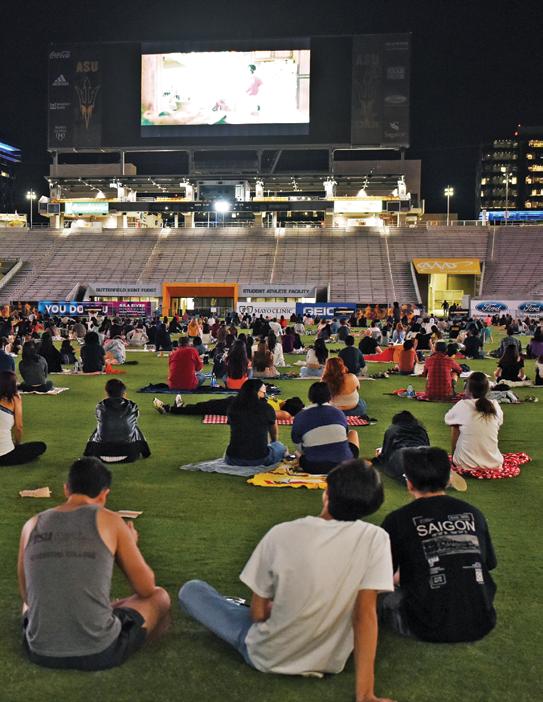
Bring a blanket, sit on the grass and enjoy a showing of “Top Gun: Maverick” on the big screen under the stars. See Pete “Maverick” Mitchell pushing the envelope as a test pilot and training Top Gun graduates. This event is part of ASU Salute to Service week, honoring all those who serve.
Friday, Nov. 10, 7 p.m., Mountain America Stadium asu365communityunion.com
Free Family
Prepare to laugh out loud as ASU 365 Community Union transforms the indoor club space at Mountain America Stadium into a comedy club. The club will showcase an exceptional lineup including Larry Owens, as seen on “Abbott Elementary”; Marcello Hernandez, as seen on “Saturday Night Live”; and Jessie Johnson, as seen on the “Bad Friends” podcast.
Saturdays, through Nov. 4, Mountain America Stadium
asu365communityunion.com
Ticketed

ASU’s West campus hosts the annual Native American Heritage Festival, featuring the Veterans Day Weekend Traditional Pow Wow. Celebrate with dancers and drum groups, and enjoy authentic Indigenous cuisine.
Saturday, Nov. 11, 11 a.m.–10 p.m., West campus Fletcher Library lawn destinationwest.asu.edu
Free Family
Seen by more than 130 million people worldwide in 53 countries and 22 languages, the Tony Award-winning musical phenomenon “Les Misérables” is undisputedly one of the world’s most popular Broadway shows. The revolutionary tale features the breathtaking songs, “I Dreamed a Dream” and “On My Own.”

Tuesday, Dec. 5–Sunday, Dec. 10, ASU Gammage asugammage.com

Ticketed Family
Ticketed Family Dec.
Visit asuevents. asu.edu for events.
Visit thesundevils. com for athletics.
In Irma Herrera’s solo performance piece, “Why Would I Mispronounce My Own Name?” she gathers notes from American history and laugh-out-loud humor to examine what it will take for all of us to get along. The 20-plus characters she portrays invite audiences to experience what’s in store for a Mexican American girl who leaves a segregated South Texas town in search of educational and economic opportunities.
Saturday, Dec. 9, 7:30 p.m., ASU Kerr asukerr.com
AUGUST
31 vs Southern Utah (Thu)
TEMPE, AZ
SEPTEMBER
9 vs Oklahoma State (Sat)
TEMPE, AZ
16 vs Fresno State (Sat)
TEMPE, AZ
23 vs USC (Sat)
TEMPE, AZ
30 at California (Sat)
BERKELEY, CA
OCTOBER
7 vs Colorado (Sat)
TEMPE, AZ
21 at Washington (Sat)
SEATTLE, WA
28 vs Washington State (Sat)
TEMPE, AZ
NOVEMBER
4 at Utah (Sat)
SALT LAKE CITY, UT
11 at UCLA (Sat)
PASADENA, CA
18 vs Oregon (Sat)
TEMPE, AZ
25 vs Arizona (Sat)
TEMPE, AZ
See all details of games and ticket options at thesundevils.com

Cam Skattebo, #4, running back, junior

A time-honored tradition, ASU Homecoming brings together students, parents and alumni to celebrate our Sun Devil spirit. The weeklong festivities highlight all things Sun Devil through athletic events, entertainment and fun activities both on and off campus.
Sunday, Oct. 22–Saturday, Oct. 28 alumni.asu.edu/homecoming
Join the annual Sparky’s Challenge 10K, 5K and 1-mile event. Begin Homecoming Week on the right foot with this family-friendly event for participants of all ages and ability levels. You can choose to walk or run any of the distances.
Sunday, Oct. 22, check-in begins at 2 p.m., ASU West campus, registration required startlineracing.com
Free Family
Celebrate the golden anniversary of Sun Devil Football’s Fiesta Bowl championship seasons. This event honors the players and coaches who built Sun Devil Football for over a century.
Friday, Oct. 27, 11 a.m., Omni Tempe Hotel at ASU, 7 E. University Dr., Tempe alumni.asu.edu/legends
Ticketed Family
The Lantern Walk was first celebrated in 1917 to pass the torch of spirit, pride and tradition from the senior class to incoming students. On the eve of the Homecoming football game, students, alumni, faculty, staff and friends climb to the top of “A” Mountain carrying lanterns and follow in the footsteps of generations of Sun Devils.
Friday, Oct. 27, meet at the base of “A” Mountain with a DJ at 6 p.m. Climb starts at 6:30 p.m. alumni.asu.edu/homecoming
Free Family
Student organization floats, the ASU Marching Band, colleges, departments, community organizations, local celebrities and Sparky parade down University Drive. After the parade, join the block party for food, fun, entertainment and tents hosted by ASU units.
Saturday, Oct. 28, before the football game alumni.asu.edu/homecoming
Free Family
Gameday is what every fan looks forward to this season as we welcome Coach Kenny Dillingham and a retooled Sun Devil Football team for the start of a new era here on campus. Every Gameday starts with Sparky’s Touchdown Tailgate, a free pregame party complete with live entertainment, tailgate games, special guest appearances and big screens streaming some of the biggest college football games. alumni.asu.edu/gameday
Free Family
Saturday, Oct. 28, Mountain America Stadium thesundevils.com
Ticketed Family

Sun Devil Rewards has exclusive swag for you and your crew. Redeem Pitchforks to score football tickets, plus ASU-branded apparel and gear. Tailgates and football games are available for check-in and when you’re at Sparky’s Touchdown Tailgate, be sure to look for a secret word displayed for all to see.

Get started today! sundevilrewards.asu.edu

Starbucks is developing a new sustainability learning and innovation lab at Hacienda Alsacia, the company’s agronomy headquarters for research and development, located in Costa Rica.
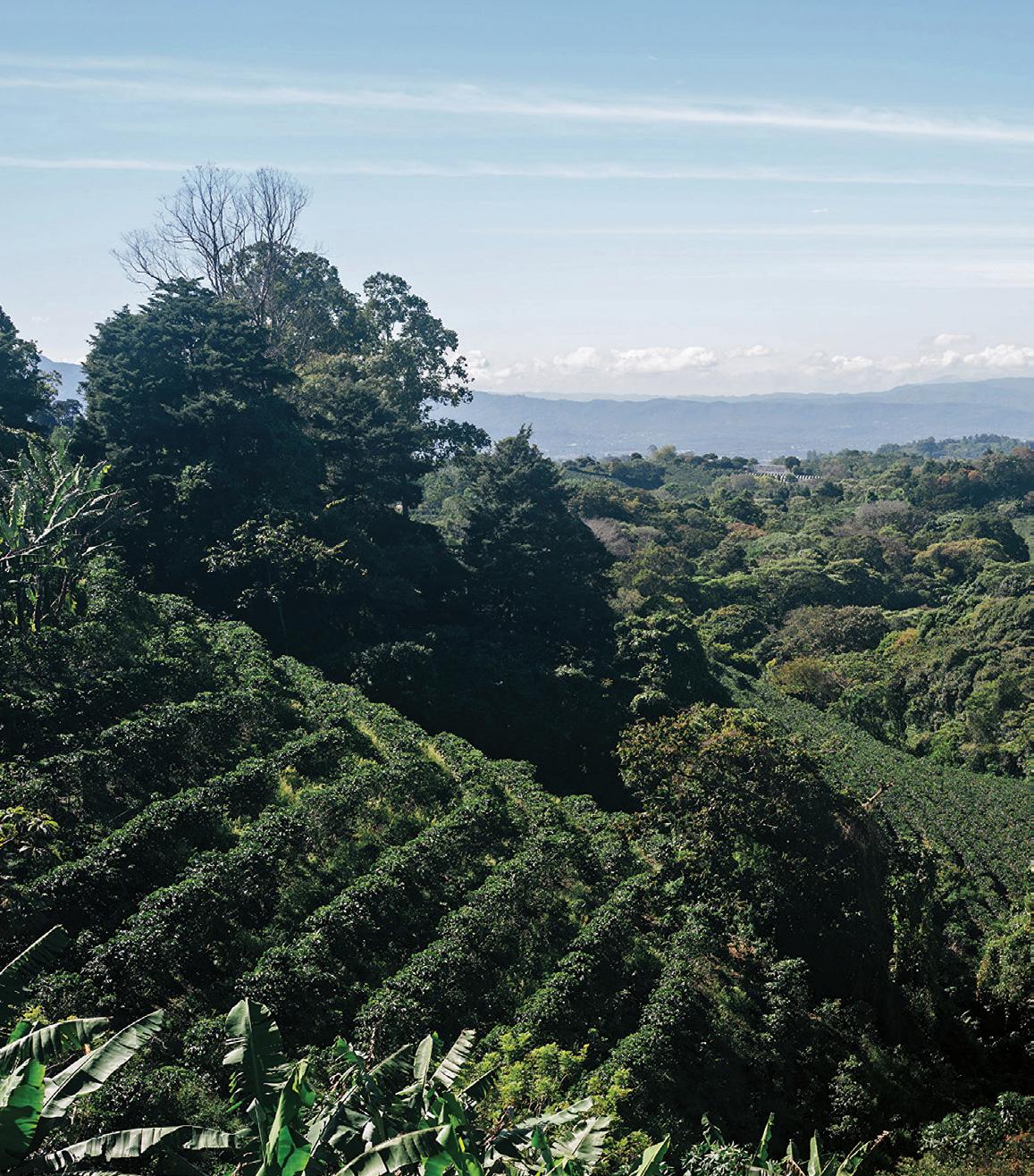
ASU will play a key role in offering educational programming at the hub. The first wave at the farm will include study abroad opportunities for students in ASU degree programs such as sustainability, sustainable food systems, global agribusiness and environmental and resource management.
Expected to open by 2026, it will provide hands-on and virtual learning opportunities for not just ASU students, but also researchers, industry leaders and Starbucks employees. From there, these leaders will work to innovate and scale sustainable solutions for some of the world’s most challenging environmental and social issues, including climate adaptation and agricultural economics.
Learn more at sustainabilityinnovation.asu.edu
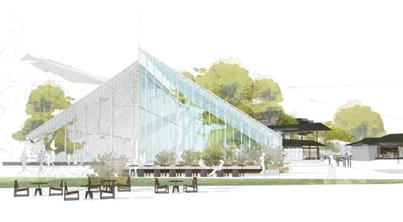
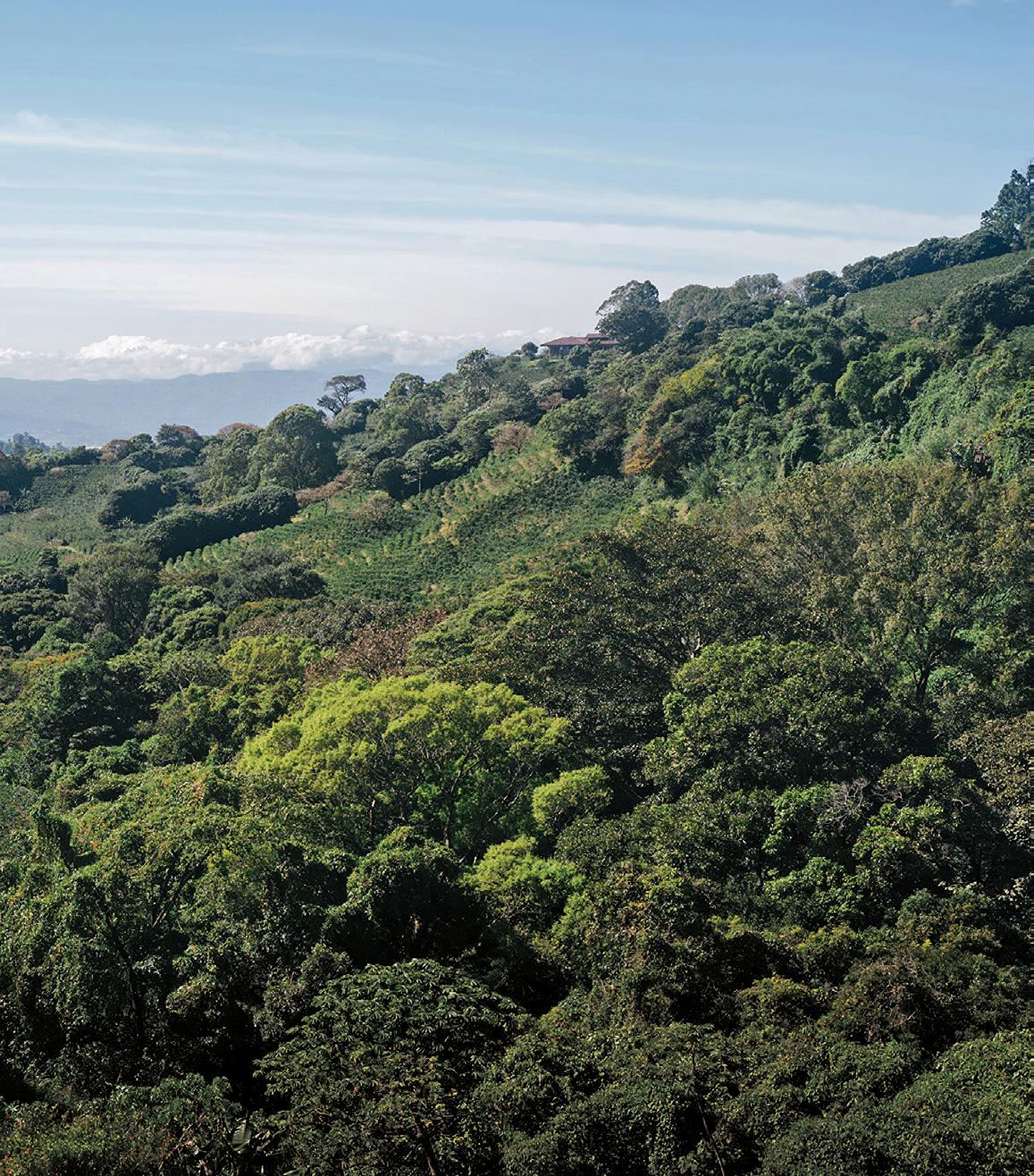
For the fifth consecutive year, the National Academy of Inventors and the Intellectual Property Owners Association ranked ASU in the top 10 among U.S. universities for utility patents. In the annual top 100 rankings, ASU tied with the University of Michigan for the No. 10 spot and ranked No. 11 worldwide.
ASU secured 160 U.S. patents in 2022 — up from 153 in 2021— joining MIT, Stanford University, The University of Texas, Purdue University, Caltech and Harvard University in the top 10.
A few 2022 patents include foldable quadrotors, prosthetic limbs and a powergenerating brick.
Learn more at skysonginnovations. com
Applied Materials Inc., a leader in materials engineering used to produce nearly every new chip and advanced display in the world, announced an alliance with ASU, aided by the Arizona Commerce Authority, bringing over $270 million to the MacroTechnology Works building at ASU Research Park to create a shared research, development and prototyping facility — the Materials-to-Fab Center. The center will provide students, faculty and Arizona’s businesses with opportunities for hands-on learning and research on the same 300mm equipment that Applied Materials produces for leading-edge production fabs.
“The MTF Center will accelerate the development, commercialization and manufacturing of next-generation U.S. semiconductor-based technologies while bolstering the state’s infrastructure, workforce and research capabilities,” says Sandra Watson, president and CEO of the Arizona Commerce Authority.
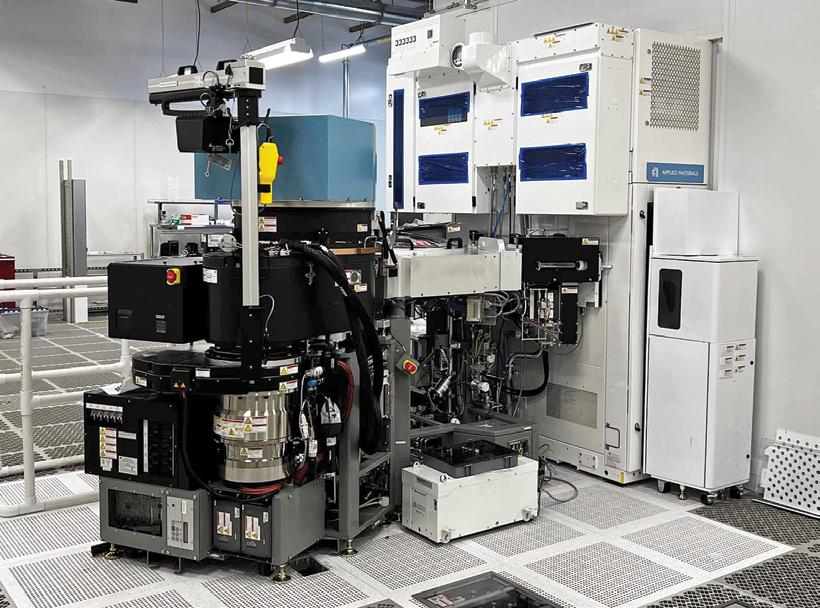
Design of the center has already begun, and the new lab is expected to be operational within two years.
Learn more at neweconomy.asu .edu/news
A team of ASU students will save the U.S. Department of Defense five years of work as part of the solution created for the Hacking for Defense class, offered at the New College of Interdisciplinary Arts and Sciences at ASU’s West campus.
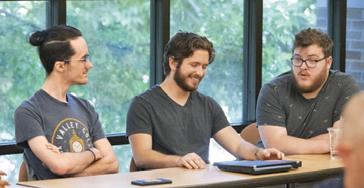
Herberger Institute professor — and choreographer, artist and author — Liz Lerman recently became a 2023 Guggenheim Fellow, one of the highest honors for visionaries in humanities and social sciences. Lerman, also a recipient of a 2002 MacArthur “Genius Grant,” has shaped the dance field and how dance communicates complex issues.
The Association of American Universities selected ASU into its membership, comprising 71 of the nation’s top research universities, including Harvard, Stanford, MIT, Johns Hopkins and UCLA.
During the spring semester, applied computing students Johnny Tamborrino, Getachew Yirga, Jacob Selover and Alexander Edwards worked on a challenge related to weapons qualifications used by the Army National Guard in Ohio. The challenge comes from the need to automate the way the Army records weapons qualifications — which all soldiers in all service branches must complete yearly — instead of using paper records. The team’s solution for digitizing and automating the process was so effective that the DOD plans to implement it into all service branches to save an estimated five years of time and work.
She continues her artistry as a senior fellow at the Yerba Buena Center for the Arts, where she is creating a museum installation, and as a fellow at the Center for the Study of Race and Democracy at ASU.
by subscribing to the ASU News e-newsletter at news.asu.edu/ subscribe
Members collectively help shape policy for higher education, science and innovation; promote best practices in undergraduate and graduate education; and strengthen the contributions of leading research universities to American society. As a group they earn a majority of competitively awarded federal funding for research that improves public health, addresses national challenges and contributes significantly to the nation’s economic strength, while educating and training visionary leaders.
During the past two decades, ASU has increased the scale and scope of its research activity nearly six times over, making an impact on local and global communities. With $677.7 million in expenditures in fiscal year 2021, ASU ranked sixth among 750 institutions without a medical school, according to the National Science Foundation’s annual Higher Education Research and Development rankings. ASU also ranked sixth in spending of NASA funding, according to the HERD report.

“The opportunity to dive into complex problems like solving national security challenges is extremely unique and gives students opportunities to apply what they learned at ASU in meaningful ways.”
— ANGELA ASPITO, A HACKING FOR DEFENSE INSTRUCTORIn two decades, research activity at ASU increased nearly six times over.
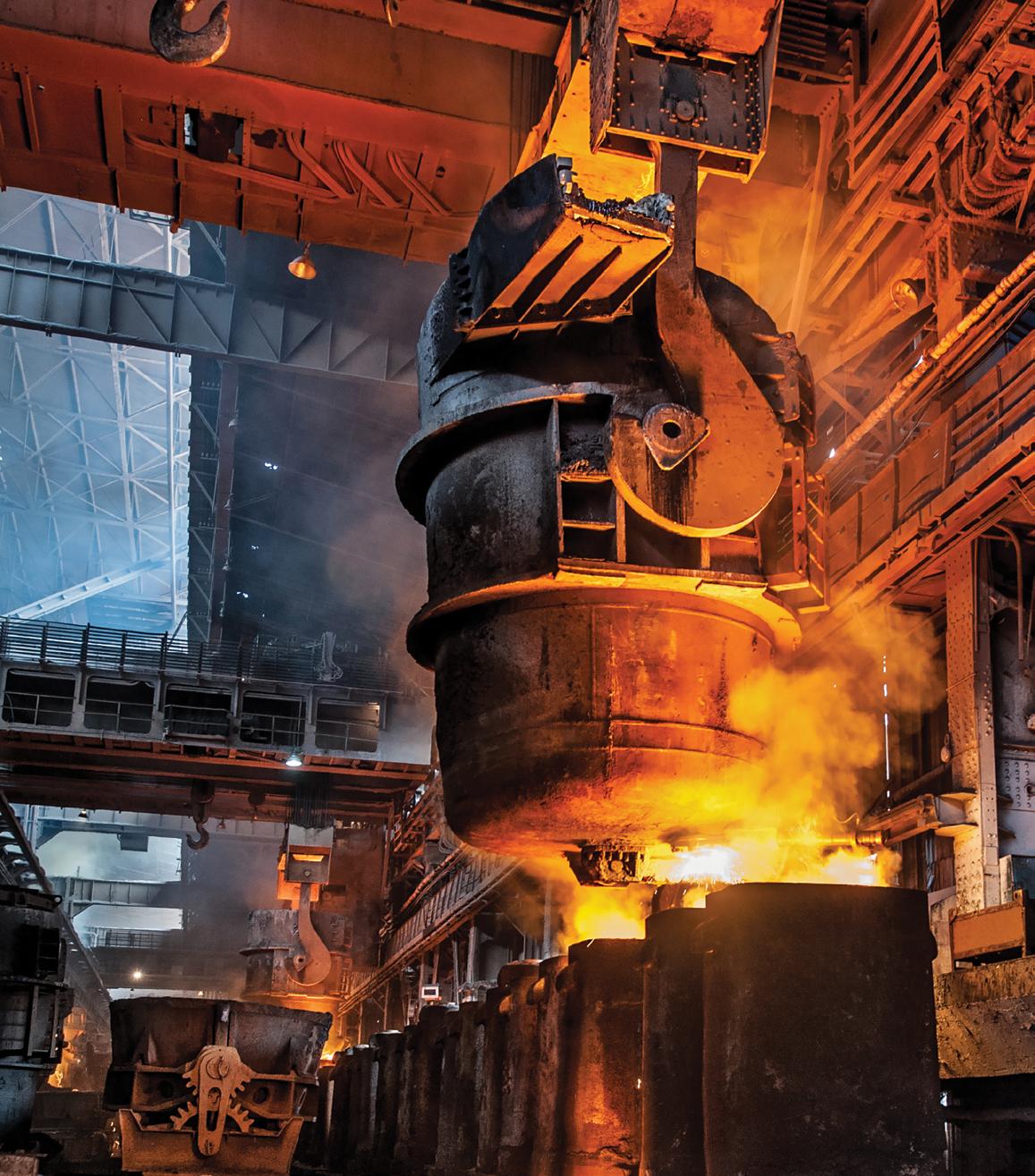
The U.S. Department of Energy selected ASU to receive up to $70 million to establish a new Clean Energy Manufacturing Innovation Institute devoted to fighting greenhouse gas emissions from the use of heat during industrial processes. ASU will lead the multi-institution effort known as Electrified Processes for Industry Without Carbon, or EPIXC.
“The industrial sector accounts for more than 30% of the nation’s greenhouse gas emissions, and fossil fuel-driven process heating — from pasteurizing milk to melting steel — is the most significant contributor to those emissions,” says Sridhar Seetharaman, vice dean of research and innovation in the Ira A. Fulton Schools of Engineering and EPIXC director.
EPIXC will support the expanded use of clean electricity for process heating and dramatically reducing CO2 emissions across industrial sectors, including iron and steel, chemicals, petroleum, food and beverage, forest products and cement. It will operate as a public-private partnership conducting research, development, demonstration and deployment of relevant technologies, as well as necessary workforce training.
Go to epixc.org

Over 5 million U.S. children will experience the death of a parent or sibling by the time they are 18. This is where a program developed by ASU can make a difference.
The program helps prevent long-term depression experienced by bereaved children, according to a study published in the Journal of the American Academy of Child and Adolescent Psychiatry. In a randomized trial, researchers with the ASU REACH Institute found that involvement in a 12-session program for parents and youth in families that had experienced the death of a parent led to a 50% reduction in the onset of major depression 15 years later when the youth were young adults. This is the first study to demonstrate that a program for bereaved children prevented the development of major depression when they reached adulthood.
In the program, caregivers learn practical tools to care for themselves and to build a supportive, positive family environment for their children. Children and adolescents learn and practice effective coping and emotion regulation tools to deal with their grief as well as everyday stressors they encounter.
The science-driven program is available to mental-health care providers to learn and use. Parents and caregivers can also access the program.
Go to reachinstitute.asu.edu
Nine Flinn Scholars, winners of the state’s most prestigious scholarship, chose the Sun Devil life, nearly half of this year’s 20 winners.
The scholarship, supported by the Phoenix-based Flinn Foundation and Arizona’s three state universities, covers the cost of tuition, fees, housing, meals and at least two study-abroad experiences.

The nine first-year students will live at their respective ASU campuses in Barrett, The Honors College.
David Bloom, a student in ASU’s Walter Cronkite School of Journalism and Mass Communication, is co-starring in the Disney+ action-comedy series, “American Born Chinese.”

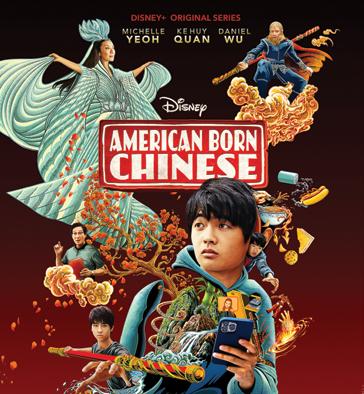
The series, which debuted in spring 2023, is a coming-of-age story featuring Academy Award-winning actors Michelle Yeoh and Ke Huy Quan and based on a 2006 graphic novel by Gene Luen Yang. Bloom plays a character named Josh, who he describes as a “fun but lovable idiot who’s trying to fit in and be cool, but it’s not working.”
Before this film, Bloom, who has been acting since he was 10, landed roles in 2022’s “Weird: The Al Yankovic Story,” an $8 million production featured on the Roku Channel and other shows and movies. More recently, he wrapped on “Screams from the Tower,” a gay coming-of-age comedy in which Bloom will receive top billing.
David Bloom“I picked ASU because they were most aligned with what I want to go after, especially in business.”
— SAM BENAVIDEZ, FLINN SCHOLAR AND FIRST-YEAR STUDENT
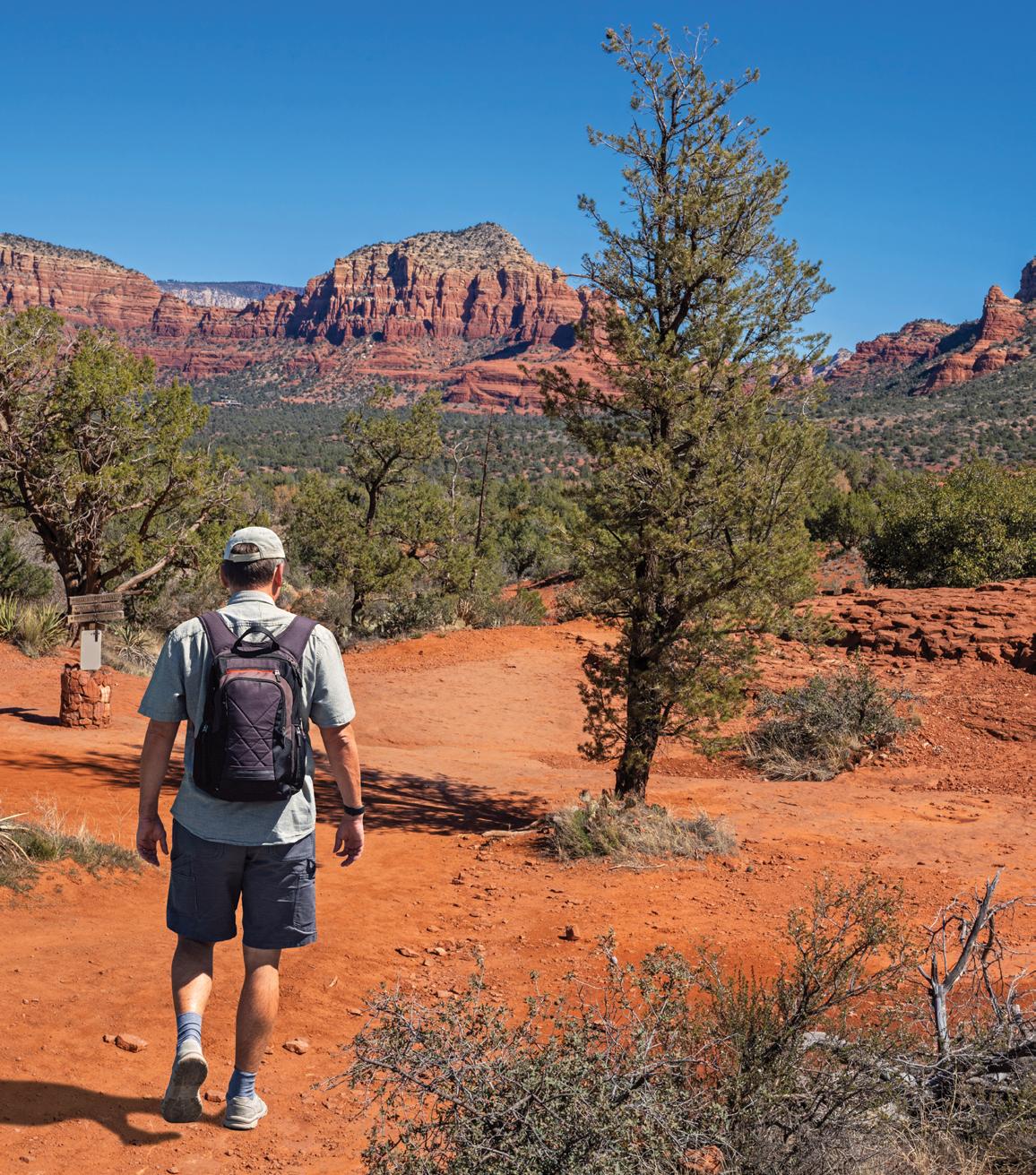
A $4.5 million grant, funded by the National Institute on Aging, a division of the National Institutes of Health, will explore the possibilities of using aerobic exercise to slow the progression of Alzheimer’s disease.
Professor Fang Yu, Edson Chair in Dementia Translational Nursing Science at the Edson College of Nursing and Health Innovation, and her team will conduct the first-ever sequential, multiple assignment, randomized trial for Alzheimer’s disease. This builds on Yu’s previous work, which found that a six-month exercise program reduced cognitive decline compared to the natural course of changes for Alzheimer’s. This new phase will examine the best exercises to improve aerobic fitness in older adults with early Alzheimer’s and how those exercises impact memory.
For the study, the team seeks more than 100 volunteers from Arizona — 65 and older — who have noticed changes in memory.
To learn more, go to asubeat.com
“This research could impact millions of people [with Alzheimer’s], potentially giving them some hope of relief from a terrible disease that steals their very essence.”
— JUDITH KARSHMER, EDSON COLLEGE DEAN
Researchers from ASU, Georgia Institute of Technology and the University of Michigan found that nearly 800,000 Phoenix residents would need emergency medical care for heatstroke and other heat-related illnesses if a multiday blackout coincided with a heat wave.

RJ Dog Park at Pecos Park in Phoenix is home to Arizona’s first Passive Daytime Radiative Cooling Ramada. The special surfaces emit their own heat directly into space with only partial absorption, reducing heat.
The study, published in Environmental Science & Technology, suggests that a two-day power outage with power gradually restored over the next three days during a heat wave would deprive thousands of residents of air conditioning, sending an estimated 789,600 Phoenicians — nearly half the city’s residents — to the ER. This scenario would overwhelm the city’s hospitals, which only have 3,000 ER beds, causing the deaths of roughly 12,800 people.
Study co-author David Hondula, researcher and associate professor in ASU’s School of Geographical Sciences and Urban Planning and head of Phoenix’s Office of Heat Response and Mitigation, says that while officials have been deeply concerned about potential illnesses and deaths during a heat wave and blackout, “This is the first time we have seen a number, and it’s obviously quite an alarming number.”
Defensive strategies, such as planting trees to shade half of all streets and installing reflective “cool roofs” on every building, would reduce deaths by 27% and 62%, respectively, according to the study. Hondula and other researchers will continue outlining and implementing strategies to reduce risk.
Learn more at sgsup.asu.edu
The work is part of a larger effort to explore strategies and technologies to keep Arizona residents, including canines, cool. sustainabilityinnovation.asu.edu
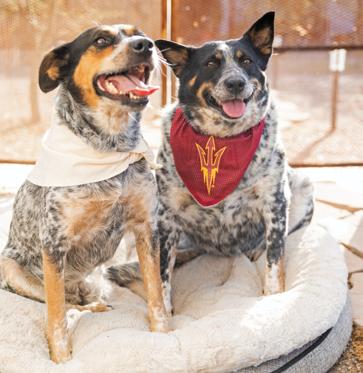
A recent study revealed that a dog’s social support network proves key to healthier aging. Led by ASU School of Life Sciences Assistant Professor Noah Snyder-Mackler and graduate students Bri McCoy, ’20 BS biological sciences and Layla Brassington, ’12 BS biological sciences and ’22 MS molecular and cellular biology, the study revealed a dog’s social support has a significant influence on well-being — five times more than factors such as finances, household stability and owner age. The study found that:
• Having more social companions, including other dogs, is crucial for a dog’s health.
• More children in the household had a negative association with dog health. It’s not the children per se, Brassington says, but the attention. “The more children or time that owners dedicate to their children likely leads to less time with their furry children,” he says.
• Dogs from wealthier households had more disease diagnoses, attributed to better access to medical care and frequent vet visits.
Learn more at science.asu.edu
Arizona cattle dog rescues Chela and Patty.“What we found from initial studies were some pretty substantial positive results in terms of these coated shelters’ ability to provide a better environment for pedestrians.”
— DAVE SAILOR, DIRECTOR OF THE SCHOOL OF GEOGRAPHICAL SCIENCES AND URBAN PLANNING
You love to learn. But you hesitate to click on a video that lacks a verified source. That’s where ASU’s Learning Sparks comes in. These 150 videos meld the latest film techniques with academic expertise to share insights from over 40 faculty members.

Looking to learn for learning’s sake? Interested in developing knowledge to upskill in your career? Want to better understand the changing world? Then tap into these resources. Each five-minute video harnesses a condensed but potent learning experience on topics like generative AI, semiconductors, climate solutions, ocean acidity, pollution and virtual reality.
So what are you going to learn today? Check out your options at sparks.learning.asu.edu
Athena Aktipis, associate professor of psychology and a faculty member of the Biodesign Center for Biocomputing, Security and Society, shares knowledge about building community resilience in the face of a crisis.
3 core skills to master for career success

18
How to network
22
“These experiences were designed to ignite curiosity for learners in a way that catches fire and turns into a passion or even a fulfilling career.”
— MARIA ANGUIANO, EXECUTIVE VICE PRESIDENT, ASU’S LEARNING ENTERPRISE
Dakota Webber, ’20 MEd in higher and postsecondary education
She’s the assistant director of career readiness at the West campus for Career Services and has experience in career development, internship programming and career content.

IN TODAY’S WORLD, technology can dominate conversations about necessary skills for today and tomorrow. These indeed are crucial skills, but what about the nontechnical core skills needed to flourish in an ever-evolving world?
Navigating the world of work means strengthening skills such as communication, equity and inclusion, and leadership — timeless for succeeding no matter how technology-driven workplaces become. The beauty of these core skills is that they transfer across any industry and any organization.
Our team in Career Services has explored skills employers look for in our workforce. Our work is guided by the career competencies defined by the National Association of Colleges and Employers, as well as through interviews with employers across the Valley.
Let’s dive into three core skills to master for your career success.
Critical thinking involves analyzing data or information to find solutions to challenges. In the workplace, this might involve taking the appropriate course of action in a stressful work situation such as when a doctor must triage a patient in the emergency room. Another example could be an
engineer having to decide what materials should replace an older material in an elevator.
You can exercise this skill by using articles that include graphs or numerical data; practice making sense of the data. What does this data suggest? How can you determine if this data is reliable? How do you find out if the data is free of bias? Then identify a problem that the data might help illuminate. What solutions might the data suggest?
Critical thinking happens every day, and as you practice in a more intentional, focused way, you will be able to identify solutions, then communicate these more
effectively. And you’ll be able to articulate the value you bring to your work.
Innovation is the ability and process of generating or approaching existing ideas in new ways. Every employer is looking for the next big idea or creative solution, and you can impress your supervisors and
Go to Career Services for numerous opportunities, from help with resumes to mock interviews, to videos and articles. career.asu.edu
CareerCatalyst offers numerous courses, such as Resilience for Everyone, Problem-Solving, Creative Thinking and more. careercatalyst.asu.edu
co-workers by leveraging this skill. A great example of innovation is Dreamscape Learn at ASU. The university identified a need for virtual reality learning driven by immersion and storytelling and found a way to create and implement this learning-byexperiencing example into the classroom.
Practicing innovation in your life starts with identifying areas of need in your workplace or community. For example, if you have noticed that there is an issue with littering in your neighborhood you can collaborate with your neighbors to organize a weekly cleanup day — or brainstorm even more effective ways to reduce the problem. Once you’ve identified challenges, you can take risks and collaborate on solutions.
Resilience is the ability to bounce back from challenges and do it with optimism and positivity. All of us will face some sort of adversity in our jobs; we’re defined by the way we react to these experiences. An example of resilience at work is being open and receptive to criticism during annual reviews. Resilient employees take feedback as an opportunity for growth. Resilience takes time and diligence to master, but one place to start is to evaluate the way you react to uncomfortable situations whether in your life or even while enjoying movies, books or TV
shows. See how negative situations make you feel. This will help you recognize these feelings and reactions, so that you can begin to adjust your response when confronted with setbacks in real life.
Just like building muscle, you have to work on these skills to master them. The effort will pay off. Not only will these skills help you in the workplace, they also will help you succeed in life. ��
“ Practicing innovation in your life starts with identifying areas of need in your workplace or community. ”
Using mindfulness, this course will help you develop skills to reduce stress. You’ll learn:

• How to define stress.
• How stress affects your brain’s functioning.
• Your triggers and indicators of stress.
• How to integrate breathing exercises and other practices into your life. Learn more at careercatalyst.asu.edu
Online
This program with State Farm provides learners with the knowledge for life and work in the 21st century. Eligible students everywhere can benefit from a personalized and comprehensive approach to higher education that connects students, faculty, mentors and employers.
pff.asu.edu
Networking Online Job search
ASU’s Learning Enterprise launched a new ASU for Life pilot program designed to help new graduates navigate work and life after college.
asuforlife.asu.edu
Free Networking Online Job search
To succeed in the workplace, you’ll need to master presenting to a group of people. This course, “Public Speaking and Presentations,” will help you feel more prepared for your next presentation and apply it in your career. $49 with a digital badge. careercatalyst.asu.edu

Online Self-paced
Move your career forward in this program addressing the need for more skilled workers in IT, cybersecurity and advanced manufacturing. Suitable for anyone over 17. AZNext not only provides you with in-demand skills, but also opportunities with employers.
asuforyou.asu.edu
Free Networking Online Job search
“Principles of Sustainability” will introduce you to basic sustainability principles and how they apply in modern organizations. Become a sustainability expert. $299 with a digital badge.
careercatalyst.asu.edu
Online Self-paced
In “Collaboration for Everyone,” learn how to respond to problems, share ideas, develop habits of positivity and make productive decisions. $149 with digital badge.
careercatalyst.asu.edu
Online Self-paced
She’s an associate director of career readiness for ASU Career Services. She does 1:1 student advising, manages the team and develops content. Prior, she worked in human resources in recruiting.

these days, you’ll see something about networking. What exactly is it, and why is it so important?
Networking is a powerful career development strategy. Leveraging online networking platforms makes finding information and opportunities as easy as scrolling through your feed while you sip your morning coffee. Many career fairs, employer panels and info sessions can take place via virtual platforms, making it easy to participate even if you’re short on time or unable to travel. Use this advice to make networking easy.
Once you’ve established your profile and added contacts, stay active on the platform. Check on your connections. Try asking questions or leaving thoughtful comments on posts. Repost content with your ideas added. Follow organizations, professional associations and hashtags so your feed will become a valuable source of job openings, career events, articles and resources. While you’re online, join the ASU Alumni group and alumni groups from your college to network with other graduates. This is a quick way to get connected to a strong network.
Online or in-person events are great ways to diversify your networking strategy. Check out events offered by ASU, professional associations and other organizations. One of the easiest ways to build your network is to attend webinars or talks with guest speakers on topics you want to learn more about. Meeting like-minded people makes it easier for you to kick off a conversation. Follow up by adding your connections on LinkedIn.
1. Find opportunities
Networking has the potential to help move you forward. Building a robust professional network increases your chances of finding opportunities.
The best way to make deeper connections is by working with new people. Consider joining committees or stepping up to take on collaborative projects. Join industry-related professional associations. Volunteering is another good way to build your network.
Regardless of your professional goals, networking can make all the difference in your career development. Your network can help you find and score new opportunities. In turn, you can help others in your network find their next big opportunity. It’s all about people doing what they can to lift each other up. n
Go to career.asu.edu and on LinkedIn for videos, opportunities to meet with a career specialist and networking connections.
Discovering exciting opportunities is only half the battle. A good word from someone will set you apart from other applicants, which goes a long way toward the next recruitment steps. In a LinkedIn survey, 61% agree that regular online interaction with their professional network can lead to possible job opportunities; 35% say that a casual conversation on LinkedIn Messaging has led to a new opportunity.
3.
If you’re still unsure what that dream job looks like, lean on your network. Research what your connections are doing and ask them if they would be willing to tell you more about their careers. Getting information about job responsibilities, company culture and their daily schedules can help you narrow down your interests.
4.
In the survey of 15,000 LinkedIn users, several say networking has numerous benefits, and 80% consider professional networking vital to career success.
One of the easiest ways to network is to attend events with talks on topics that interest you. Meeting like-minded people makes it easier to start a conversation.

With a nursing school and cancer reserch in full force decades ago and a strong history of biomedical expertise in business and engineering, the university always has been at the forefront of medical care and knowledge. So it seems fitting that the Arizona Board of Regents tasked ASU with expanding medical education by launching a medical school. The new ASU School of Medicine and Advanced Medical Engineering will integrate clinical medicine, biomedical science and engineering in a unique kind of model.
ASU will continue to work with local and national health care partners to bring top medical talent, technology and research to Arizona. And ASU’s long-standing relationship with Mayo Clinic will continue to expand through the ASU Health Futures Center next to Mayo Clinic’s north Phoenix campus and the Discovery Oasis innovation zone by the Mayo Clinic Phoenix Hospital. ASU will also continue to build upon the work at the Phoenix Bioscience Core, the Polytechnic campus, and the community health, nursing and health solutions on the Downtown Phoenix campus, and health care research at the Biodesign Institute.
Learn more at health.asu.edu
Izaura Nunez Alvinez and Mandy Lu, ’22 BS health care compliance and regulations, study before their anatomy class.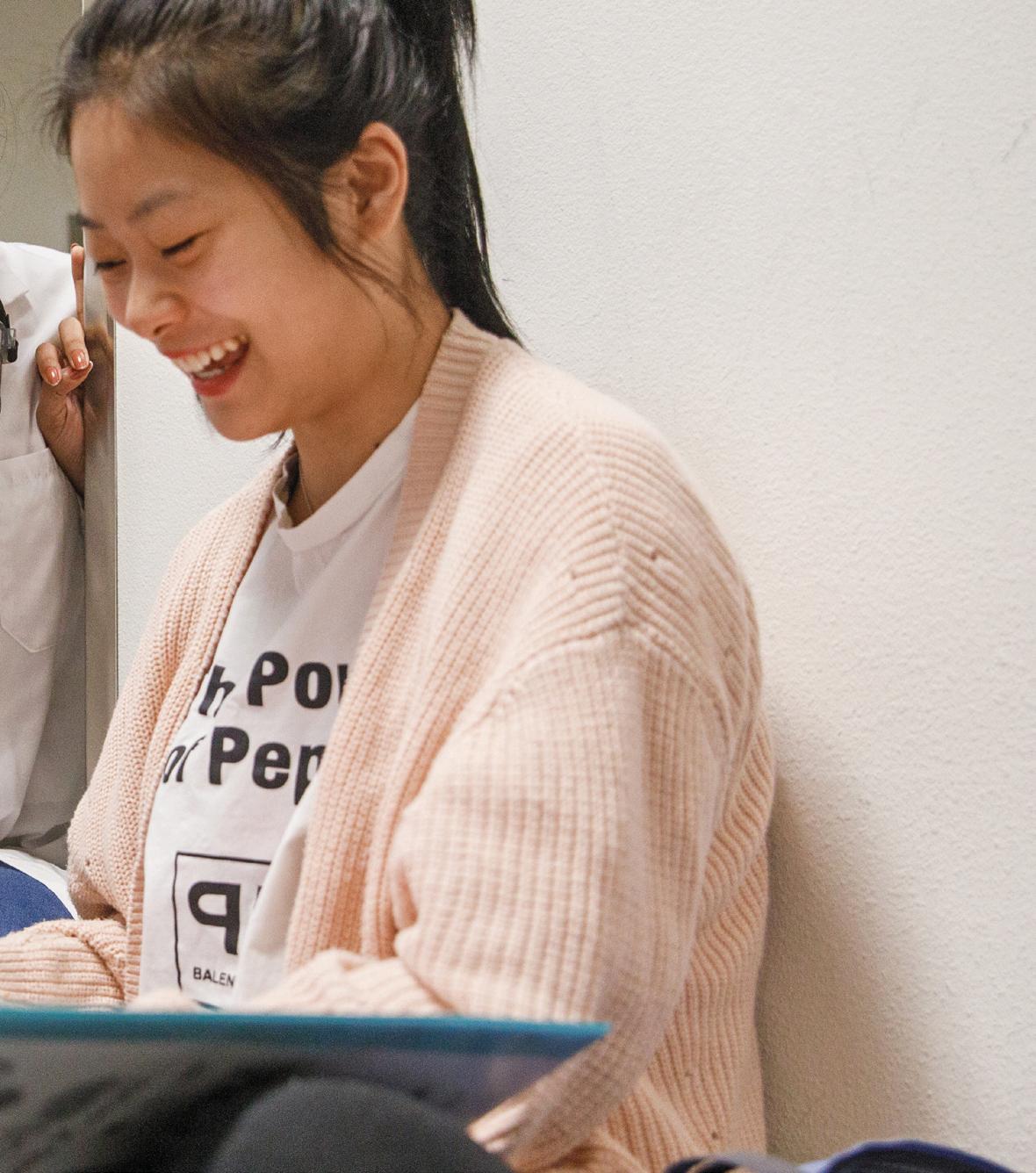
“We are focusing our full energy and innovation on improving Arizona’s health
— MICHAEL M. CROW, ASU PRESIDENT
A new treatment for Pitt-Hopkins will help children like Phoenix resident Alexandra Anderson, who suffers from the rare disease.

A new treatment from ASU is helping people with autism and children with a rare disorder called Pitt-Hopkins syndrome, a genetic disease characterized by physical, intellectual and developmental delays.
In this first-ever, double-blind clinical trial, ASU researchers demonstrated that microbiota transplant therapy, which first uses antibiotics to eliminate bad bacteria

from the intestines and then replaces it with healthy bacteria, reduces gastrointestinal symptoms and other symptoms in people with autism, as well as in children with Pitt-Hopkins.
To understand how the ASU team got to this point, you need to first go back 29 years, to when James Adams, now a professor and director of ASU’s Autism/ Asperger’s Research Program, and his wife received the news that their daughter had severe autism.
For any parent, learning your child has a severe illness with no treatment can be shattering. This was the case for James Adams and his wife, Marie, when their daughter’s doctors informed them it was only a matter of time before she would require institutionalization.
“We took it hard,” James says.
Marie Adams began learning all she could and attended a conference on autism where researchers said that nutritional support could make a difference in quality of life for people with autism.

“I was a skeptic,” admits James, “but I rapidly became a convert.”
James began to read research into the relationship between autism and GI symptoms. One
study found that antibiotic therapy could be helpful, albeit temporary.
“I realized that you could pull the weeds out of a garden, but the weeds come back,” he says. “I hypothesized that we needed to pull out the weeds with antibiotics, but then plant the garden with good bacteria.”
Recent research into the C. difficile bacteria and microbiota transplant treatment allowed Adams to have something of an epiphany — could the treatment work with autism?
The possibility of a treatment not only mattered for his family, but for many others. Autism impacts one in 36 children in the U.S. and can present a host of difficult health, social and behavioral challenges, including gastrointestinal issues. Over 22% of people with autism deal with constipation, 13% with diarrhea and 46% report a variety of GI symptoms.
Research suggests there’s a direct link between the gut microbiome and brain health. Each person has a unique network of microbiota in their intestines, a mixture of good and bad bacteria. The baby gut’s microbiome begins during the birthing process, and then soon after with the unique set of nutrients and microorganisms in a mother’s breast milk. The microbiome changes further still depending on environment and diet as children grow into adults. And, according to research at ASU and around the world, the health of the gut affects brain health, too.
“I realized that you could pull the weeds out of a garden, but the weeds come back. I hypothesized that we needed to pull out the weeds with antibiotics, but then plant the garden with good bacteria.”
—JAMES ADAMS, PROFESSOR, BIODESIGN CENTER FOR HEALTH THROUGH MICROBIOMES
Zoe Jay Hollie, a child with autism. She is the daughter of autism researcher Kelley Hollie. For many involved in this work at ASU, the search for treatments is personal.

At the same time as James was studying possibilities in this area, so was Professor Rosa KrajmalnikBrown, director of the Biodesign Center for Health Through Microbiomes. Her microbiome work had already produced clinically significant results in other arenas.
At that time, her past studies included a look at bariatric surgery and how it changes the microbiome, a collaborative effort with Mayo Clinic.
“We were able to see significant differences with just a few patients,” she says. “I took our bariatric surgery paper published in the Proceedings of the National Academy of Sciences to Dr. Adams and told him, ‘I have the people, resources and know-how to study the microbiome in kids with autism, let’s work together.’”
So the two ASU professors teamed up, and their joint effort began with a small pilot study to see if the microbiome in kids with autism was different from their peers.
“We found a significant number were missing beneficial microbes in the autistic population, which gave us a really good justification to do a microbiota transplant study, adding beneficial microbes to increase diversity,” she explains.
Adams and Krajmalnik-Brown hypothesized that by using microbiota transplant therapy, many of the GI symptoms and associated behavioral symptoms of autism might improve.
In 2017, beginning with 18 patients, Adams and Krajmalnik-Brown
pretreated the participants’ guts with a specific antibiotic to rid them of harmful bacteria. Next, the participants underwent a bowel cleanse, followed by one to two days of a high dose of healthy microbiota from carefully screened donors, and finally, seven to eight weeks of daily microbiota.
The results of the first study were impressive: Participants reported an 80% reduction in GI symptoms and initially a 23% reduction in autism symptoms, reaching nearly a 50% reduction at two years posttreatment. Their bacteria diversity increased from 25% below normal to normal initially and two years later too.
“At this point, the FDA granted us fast-track status for the treatment,” explains Adams, “and we moved on to Phase 2.”
This second phase was slated to begin in 2017 and look at 84 adults with autism. Originally a federally funded study, the pandemic intervened, delaying the research and slashing the funding.
“We had over 1,000 families impacted by autism step up and donate to help us carry out our research,” says Adams. “We were eventually able to enroll more than 50 adult patients.”
Along with the studies with autism patients, the ASU team also studied microbiota transplant therapy for children with PittHopkins. Approximately 75% of people with Pitt-Hopkins deal with severe constipation, and about 30% suffer from gastroesophageal reflux — and many require repeat hospitalizations throughout their life.
Because the treatment was only available in a pill form at the time of the study, just six children with the rare disorder could participate. But all six showed improvement.
The son of Audrey Davidow Lapidus, president of the Pitt Hopkins Research Foundation, was one of the children with Pitt-Hopkins syndrome to receive the treatment. Lapidus says it was life-changing.
“In his 12 years, this was the first year my son enjoyed his birthday and Halloween as a result of not being in pain,” she says. “Other families saw improvement not only in GI symptoms, but in mood, behaviors and irritability.”
The results have been so promising that the team acquired the FDA’s orphan drug designation and rare pediatric disease designation for Pitt-Hopkins syndrome, and following a Phase 3 study, they hope to receive FDA drug approval for their treatment.
Not only does the ASU team’s approach to the therapy stand out from predecessors because it is the first-ever treatment for Pitt-Hopkins,
“I have the people, resources and know-how to study the microbiome in kids with autism, let’s work together.”
— ROSA KRAJMALNIK-BROWN, DIRECTOR OF THE BIODESIGN CENTER FOR HEALTH THROUGH MICROBIOMES
but also because it improves core autism symptoms. It works differently from other microbiota transplant therapy in that it first begins with antibiotic treatment, followed by a bowel cleanse, then a high dose of the transplant, then a 12-week regimen of biweekly maintenance microbiota.
To prove the case for the therapy and receive drug approval from the FDA, the ASU team needs to conduct a Phase 3 trial and has formed a new company, Gut-Brain Axis Therapeutics Inc., to raise funds for the trial.
A typical day for 8-year-old Alexandra Anderson begins when her parents, Nicole and Matt, assist her out of bed. They move on to feeding Alexandra one of eight
bottles, the first being a cocktail of medicine and vitamins, her most important.
Lately, Alexandra has mastered holding her bottles independently, an exciting “inchstone” for the family. She also has taken her first steps while holding on to one of her parents.
Every inchstone in Alexandra’s life is equivalent to a milestone for other children. Born with Pitt-Hopkins syndrome, Alexandra requires around-the-clock support. Impacting fewer than 1,500 people in the U.S., the disorder has no cure, and Alexandra spends time in a special school, plus some form of therapy five days a week.
Nicole, Matt and their respective parents provide care at all other times, while also raising Alexandra’s younger sister.
Number of FDA-approved treatments for core symptoms of autism; the ASU microbiota transfer treatment could be among the first. Results were an 80% reduction in GI symptoms and a 23% reduction in autism symptoms, reaching nearly a 50% reduction at two years post-treatment.

5.5 million
Number of adults in the U.S. with autism spectrum disorder, according to the Centers for Disease Control.
This is the first-ever treatment study for Pitt-Hopkins syndrome.
“Every little thing Alexandra does in life, she has learned to do through repetition and constant support,” says Nicole Almond Anderson, executive director, branding and communications at ASU’s Thunderbird School of Global Management. “Nothing has come easy to her, and this makes the accomplishment of her taking steps and holding her bottle so monumental to us. We never take one moment for granted, ever.”
One of the most debilitating symptoms of Pitt-Hopkins syndrome is severe gastrointestinal pain — often in the form of chronic bloating and constipation that can result in hospitalizations.
“Alexandra must take MiraLAX every day,” explains Nicole,
Alexandra uses augmentative and alternative communication to speak to her mother, Nicole Anderson, through an iPad. Many living with Pitt-Hopkins syndrome are nonverbal.

’04 BA in journalism and mass communication and ’09 MNS in nonprofit studies. “She has to eat a very specific diet or she can have a severe reaction.”
Until recently, families like the Andersons had few options. While Alexandra Anderson couldn’t be part of this phase of the study because of not meeting the age requirement and difficulty swallowing pills, Nicole is optimistic that soon Alexandra can benefit, especially since the ASU team has since developed a powder form of the treatment.
For Nicole Anderson, the microbiota transplant therapy represents a full-circle moment and hope at its core. An ASU alum and employee since 2007, she could never have known the university she loves would be leading research with the potential to radically improve her daughter’s life. This research also drove the launch of the first-ever human trial for the Pitt Hopkins Research Foundation, where she sits as a board member.
“ASU has always been such a profound part of my life and it’s now so surreal to be witness to this exciting research and potential treatment,” she says. “Pitt-Hopkins syndrome is largely unknown — even by medical professionals — and we are working hard to change that. If we can eradicate the debilitating GI issues in these individuals, it’s a monumental step forward.
“Now our kids have an opportunity for a brighter, happier life. I am beyond proud that ASU is the institution driving this ‘happiness’ to provide people with a better quality of life.” ��
“Nothing has come easy to her, and this makes the accomplishment of her taking steps and holding her bottle so monumental to us. We never take one moment for granted, ever.”
— NICOLE ALMOND ANDERSON, PARENT OF A CHILD WITH PITT-HOPKINS SYNDROME
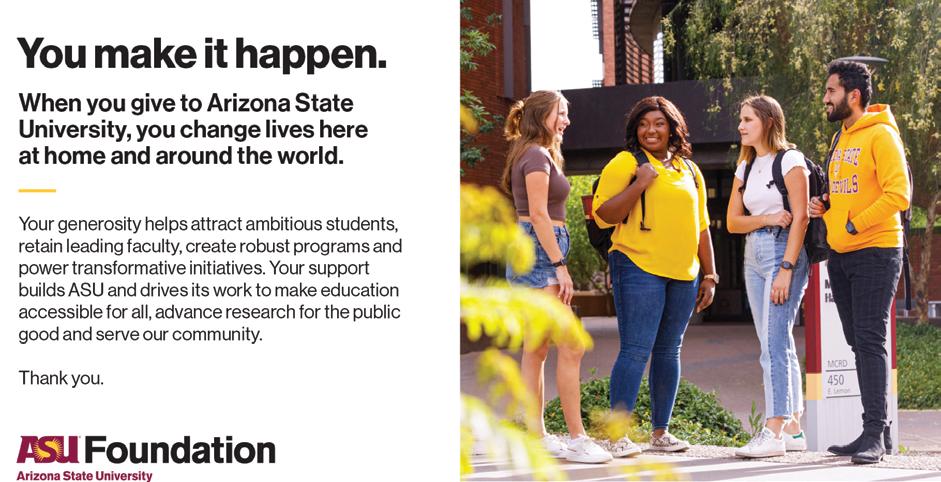

The human body reacts differently to the same number of calories ingested from high-fiber whole foods versus processed foods, according to a new study in Nature Communications. Heavily processed foods result in more calories absorbed by the body, leaving fewer for the gut microbiome. High-fiber whole foods — vegetables, oats, lentils, brown rice and fruits — journey down the digestive tract to the large intestine, where they nourish the trillions of microbiome bacteria.
Participants on the fiber-rich diet provided about 116 more calories per day to the gut microbes than those on the processed food diet. That is a clinically significant number of calories, similar to the reduction needed to maintain weight loss. In addition, participants on the higher-fiber diet had a healthier gut microbiome and more energy.
The microbiome-enhancer diet provided other benefits, like increased levels of short-chain fatty acids and an increase in hormones like GLP-1, promoting satiety.
ASU study researchers include: Rosa KrajmalnikBrown, director of the Biodesign Center for Health Through Microbiomes; Blake Dirks, ’15 BS biochemistry; Taylor Davis, ’21 MS chemical engineering; and Bruce Rittmann, Regents Professor of environmental engineering. The study was conducted in partnership with AdventHealth Translational Research Institute of Metabolism and Diabetes and funded by the National Institutes of Health.
Learn more at biodesign.asu.edu/ health-through-microbiomes
ASU researchers found that the more healthy the gut, the more energy participants had.

Researchers hone in on how tumors grow to create personalized medicine
Mehdi Nikkhah, an associate professor of biomedical engineering in the Ira A. Fulton Schools of Engineering, has been working toward personalized cancer cures for several years.
He and his ASU collaborators bioengineered a way to study tumors’ microenvironment and discovered a new role that cells play in spreading cancer. They hope to one day develop personalized treatments for patients.

Originally led by then ASU biomedical engineering doctoral student Danh Truong, ’18 PhD, and continued by Kalpana Ravi, a doctoral student in the Nikkhah Lab, the innovation replicates disease states or organs in an easily controlled environment — the chip. These microfluidic environments — rectangular pieces of plastic about the size of a long fingernail with channels for depositing live cells — are called “organs-on-a-chip.”
Using the chip technology, researchers can watch a single cancer cell move through the microenvironment, a phenomenon that is impossible to observe in a person’s body. They discovered that the gene expression of cancer cells can change when interacting with fibroblast cells — which usually aid in healing — to instead help spread cancer cells quickly.
The team worked with Mayo Clinic surgical oncologist Barbara Pockaj to better understand stromal
Tumor-on-chip next to a penny. Tumor cells form the central region (blue). The red region is injected with other cells to test treatments.
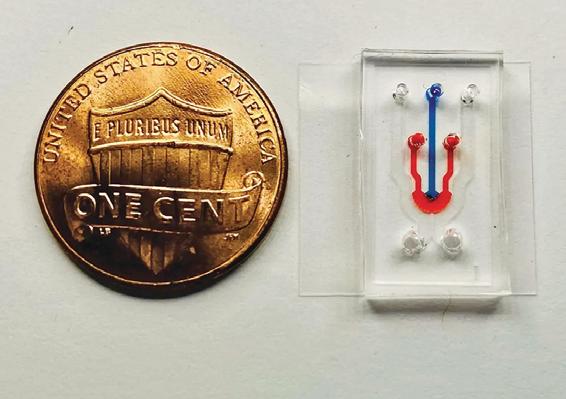
and immune cells’ role in breast cancer metastasis and with Shwetal Mehta at Ivy Brain Tumor Center at the Barrow Neurological Institute in Phoenix to explore how tumor cells spread in brain cancer.
As scientists are able to replicate a person’s specific tumor and its surrounding microenvironment — including immune cells and other proteins and tissues — on a chip, they can test how cancer cells respond to various drugs, avoiding unnecessary treatments on patients. And because the chips are inexpensive, researchers can run hundreds of tests at low costs.
“It’s not very far off that we can create fully patient-derived tumor and tissue cells and provide fully personalized medicine for cancer therapy,” says Nikkhah, an associate faculty member in the Biodesign Virginia G. Piper Center for Personalized Diagnostics and an associate professor in the School of Biological and Health Systems Engineering, one of the eight Fulton Schools. “If you design the therapeutics to knock down targeted genes or block specific pathways inside a patient’s tumor cells, you may be able to stop the spread of the tumor.” ��
 Biomedical engineering alum Danh Truong.
Biomedical engineering alum Danh Truong.

Eleven people – five graduate and six undergraduate students – helped medical companies scale to market as part of the ASU and Mayo Clinic MedTech Accelerator program. The accelerator pairs students to serve as interns with medical instrument companies from around the world.
“Our incredible student interns are not just an asset, but they have become an essential component to the success of our program,” says Dr. Steven Lester, founder and chief medical officer of the MedTech Accelerator program. Learn more at mayo.asu.edu
Shawn Zhuang of CardioStory demonstrates the company’s noninvasive cardiac pressure measuring and monitoring device on intern Ramkeerthan Konda.
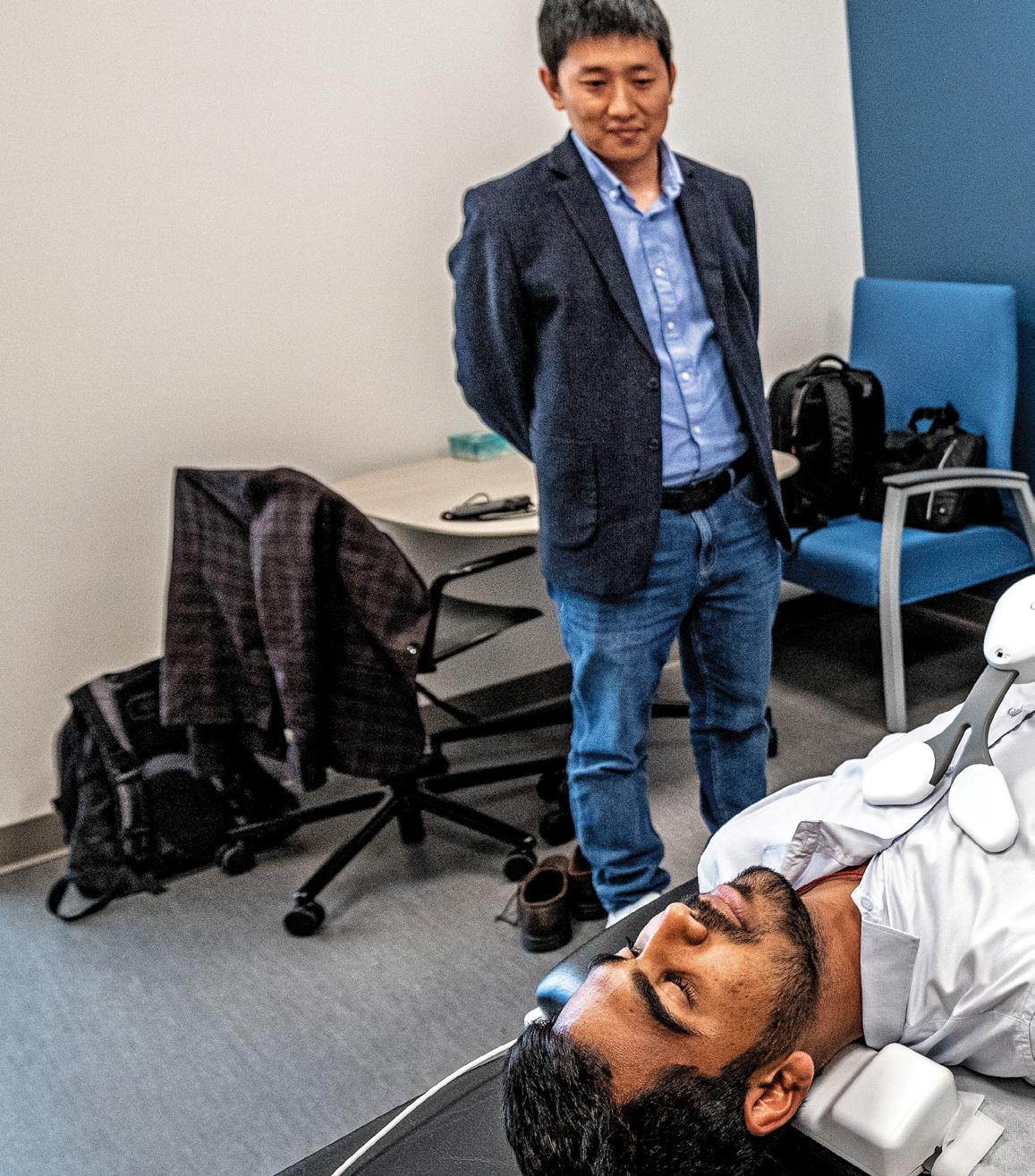
“We had one student from three years ago who applied for eight medical schools around the country and got into all eight. The MedTech Accelerator program is unique, it’s different.”
– RICK HALL, CO-MANAGING PARTNER OF THE MEDTECH ACCELERATOR
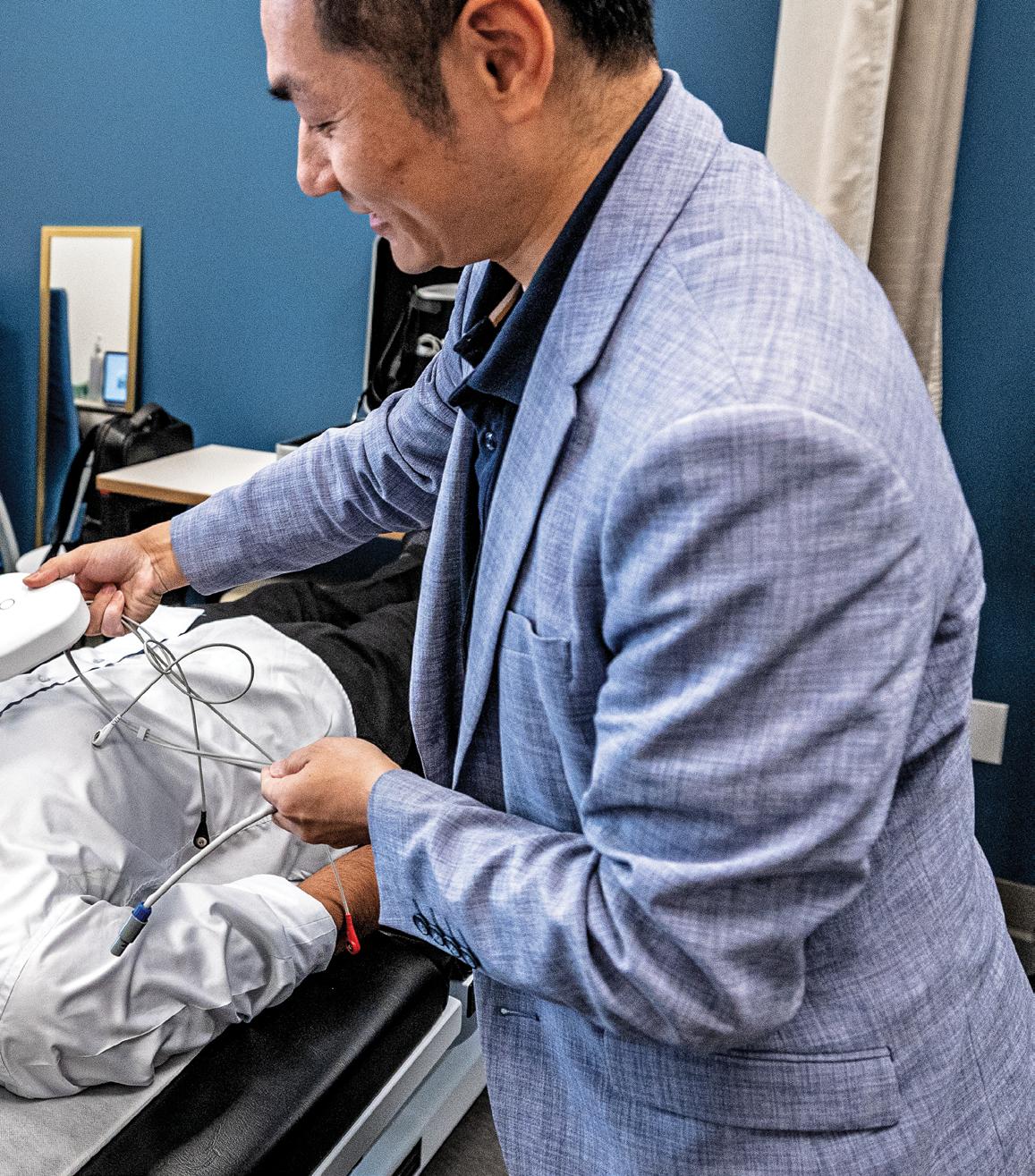
Behind a 4-inch-thick metal door with a small glass window in the far northeast corner of the Tempe campus lives ANDI, the world’s first indoor-outdoor breathing, sweating and walking thermal manikin that can be used outdoors.
Using the manikin, “We’re trying to develop a very good understanding of how heat impacts the human body so we can quantitatively design things to address it,” says Konrad Rykaczewski, associate professor in the School for Engineering of Matter, Transport and Energy and principal investigator.

“There are situations we know of in the Valley where people are dying of heat and we still don’t fully understand what happened. ANDI can help us figure that out.”
– JENNI VANOS, ASSOCIATE PROFESSOR IN THE SCHOOL OF SUSTAINABILITY, A PROJECT RESEARCHER

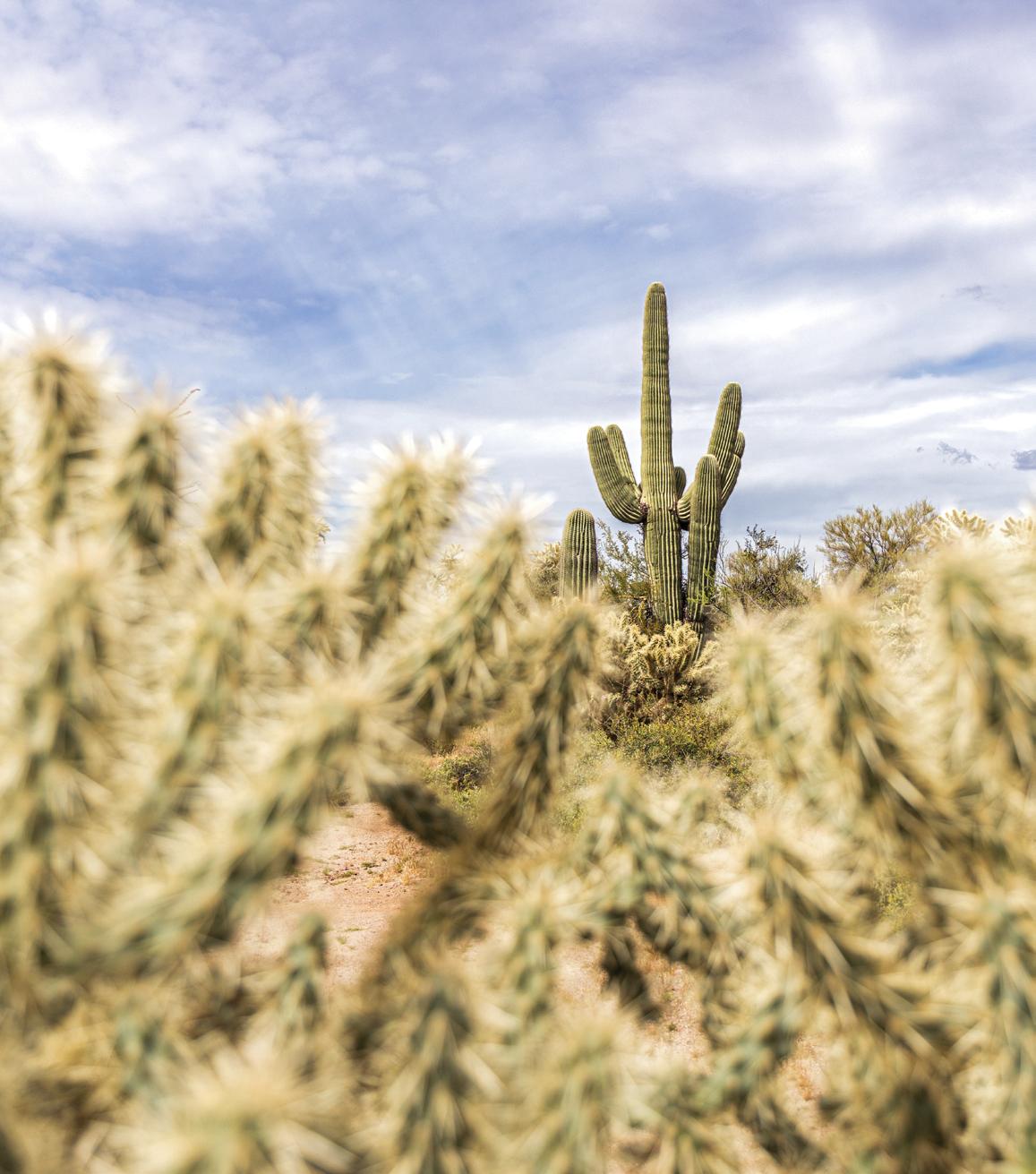
A school dedicated to studying the ocean and based in the desert? Something so improbable and dynamic could only happen at ASU.
Why? Because “Simply, life here would not be possible without the oceans,” explains Susanne Neuer, director of the School of Ocean Futures.
“Through the absorbance of heat and its distribution from low to high latitudes through currents, the ocean makes this a livable planet. Without it, we would have extreme day-night differences in temperature, somewhat like the desert planet Mars.”
The school conducts learning and discovery spanning three campuses and research stations based in the Atlantic and Pacific oceans. It includes dozens of faculty members, students and staff; the longest-running ocean research institute in the Western Hemisphere, the Bermuda Institute of Ocean Sciences; an airborne observatory; and laboratories in Hawaii and labs in Arizona that grow coral.
Learn more at oceans.asu.edu
“The ocean takes up a quarter to a third of all CO2 emissions that we emit into the atmosphere every year by fossil carbon emissions. Without this important ocean service, our CO2 levels would be much higher and our planet warmer. This affects us anywhere on the Earth, whether we live in the desert of Arizona or near a beach.”
– SUSANNE NEUER, DIRECTOR OF THE SCHOOL OF OCEAN FUTURESOur planet’s lifeline
The Bermuda Institute of Ocean Sciences, now a part of ASU, has been measuring the temperature, acidity and ocean life in the Atlantic for 120 years.
44
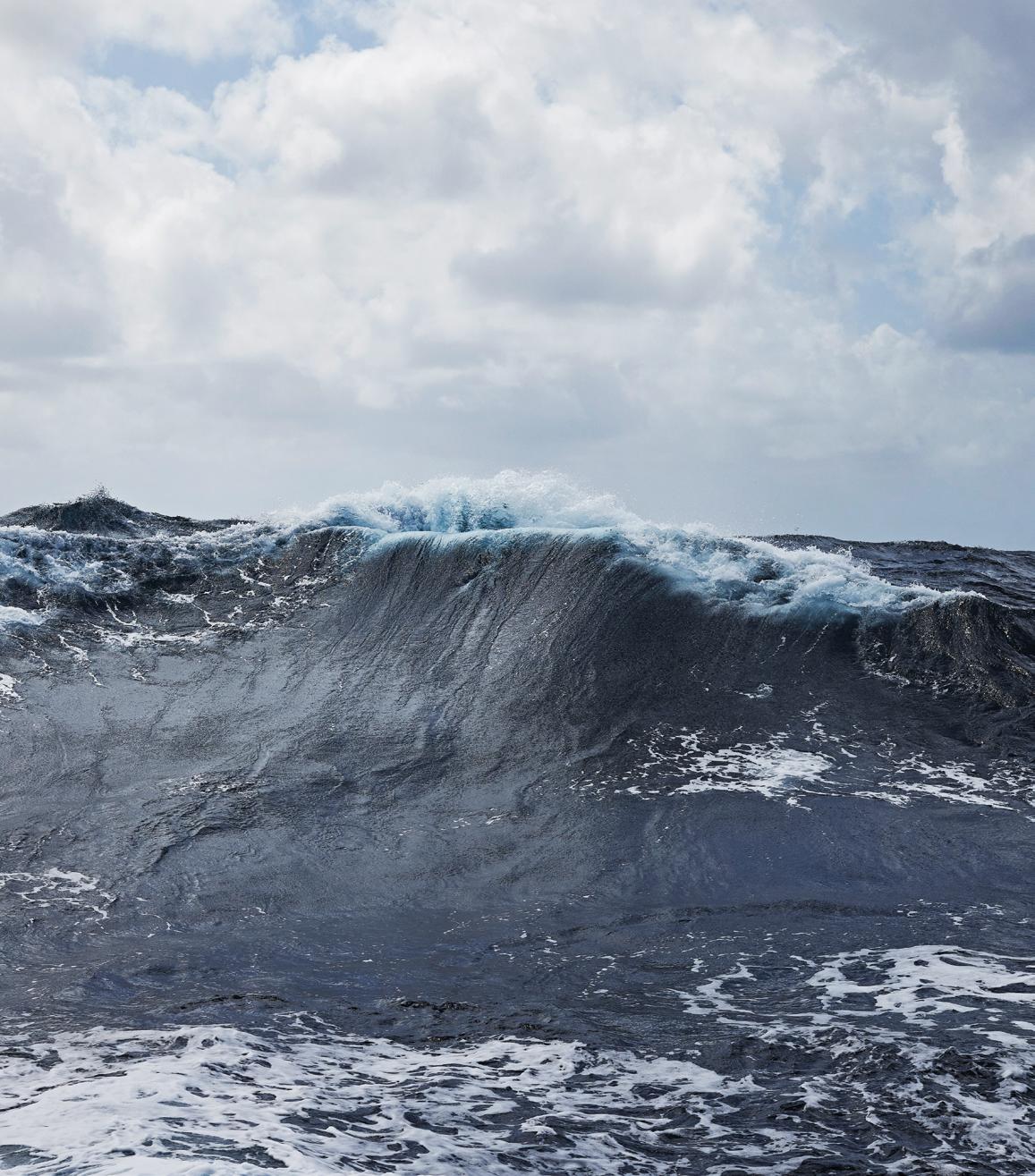
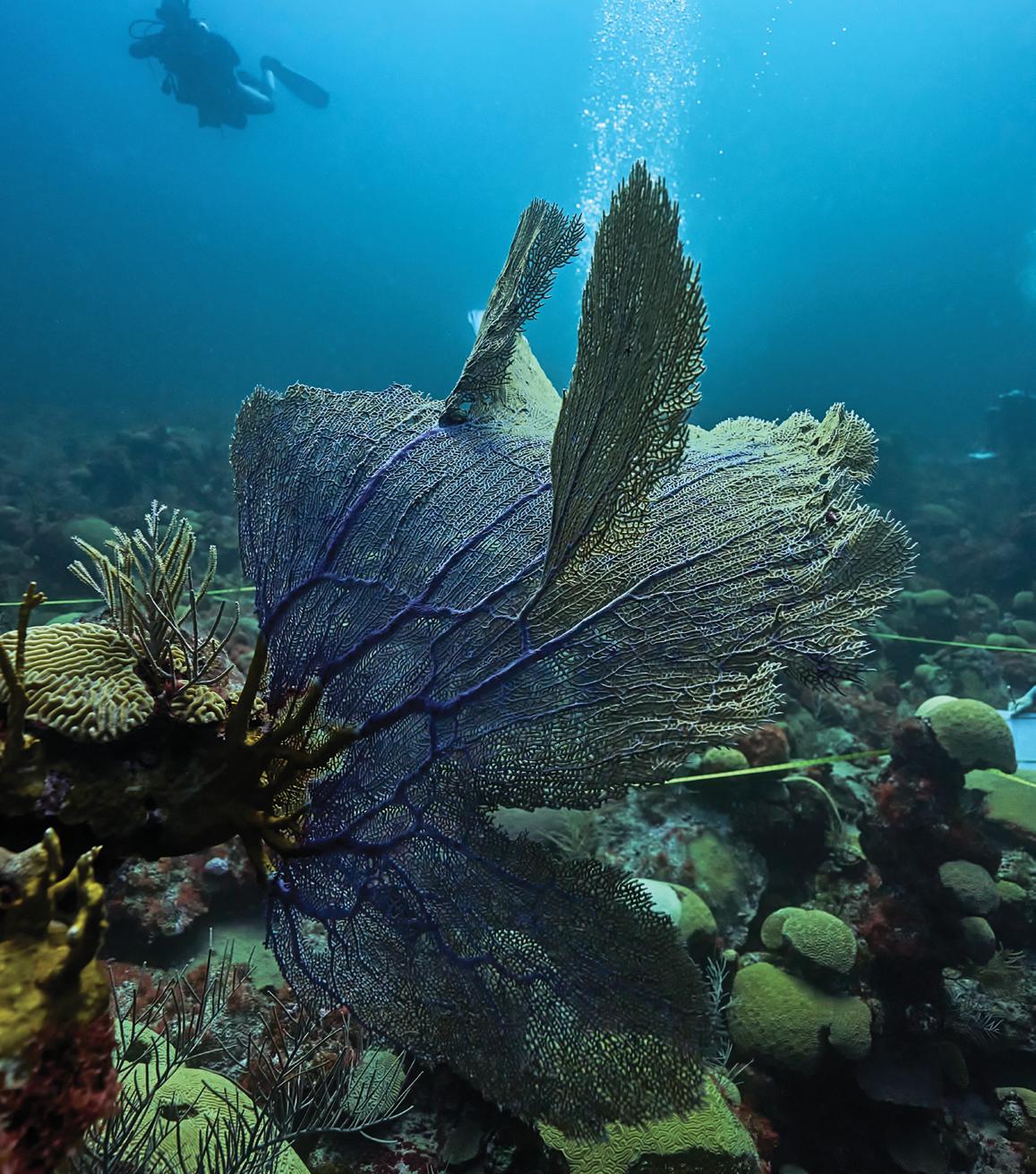

 Story by KRISTIN TOUSSAINT
Photos by JAMES DOUGHTY AND JEFF NEWTON
Story by KRISTIN TOUSSAINT
Photos by JAMES DOUGHTY AND JEFF NEWTON
In the clear blue waters of the Sargasso Sea swim all sorts of marine life: eels, white marlin and whale sharks; turtles, manta rays and even humpback whales. The sea, a region in the Atlantic Ocean that encompasses the Bermuda islands, is a hotbed of biodiversity.
But on the back of the Atlantic Explorer — a 170-foot-long research vessel owned and operated by the Bermuda Institute of Ocean Sciences, a unit of the Julie Ann Wrigley Global Futures Laboratory at ASU — second-year PhD student Yuuki Niimi hopes to catch much smaller creatures: zooplankton.
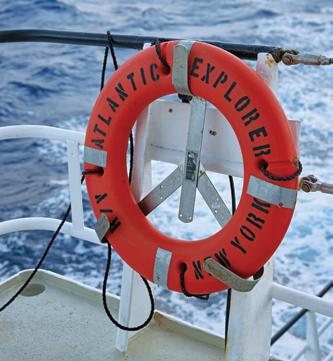
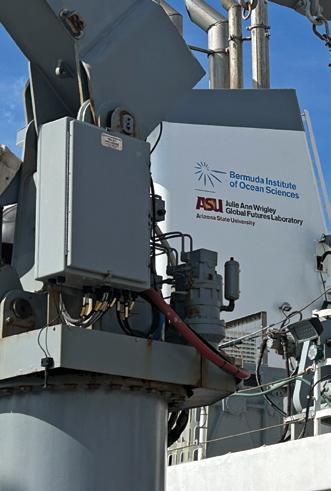
It’s the middle of the night because that’s when zooplankton swim from the ocean’s depths to the water’s surface to feed on phytoplankton. But it’s not completely pitch-black; there are lights on the ship and flashing green strobe lights on the nets being towed in the water, which temporarily blind the zooplankton, making them easier to catch.
It can be a bit scary, Niimi admits: The back of the ship, where the mechanism to lower the nets into the water sits, can flood with seawater. The nets are heavy. The boat shakes. But it’s worth it once he and his fellow researchers pull up a net to see a new world.

“The first time you bring up a net, everybody’s like, ‘What is that? That’s so weird!’” says Amy Maas, an assistant professor in the School of Ocean Futures and an ASU BIOS faculty member, who has been on research cruises with Niimi.
“It looks like a busy city, but in three dimensions, or like a galaxy spinning around. You’ve got all these
different shaped things — and none are shaped like us; they’ve got too many legs or no legs at all — and they’re zooming around in this bucket,” Maas says.
On his first research cruise, in July 2021, Niimi remembers Maas and Leocadio Blanco-Bercial — another ASU BIOS researcher and assistant professor in the School of Ocean Futures — easily identifying the different zooplankton.
But he was confused: Was that thing zooming around in the net a krill or a shrimp? The two can look similar, but krill, zooplankton also called euphausiids, have exposed gills, though you need a microscope to see that. Eventually, after multiple research trips and nights spent studying in the ship’s lab, Niimi became adept at identifying krill and pteropods.
“I can just look at it with my naked eye and say, ‘That’s this genus,’ or ‘That’s this species,’” he says.
What were once just “specks of dust” were now distinct creatures — each playing an essential role in the ocean’s overall health.
Zooplankton are tiny organisms that range from a fraction of a millimeter to centimeters in length and take a variety of shapes. Krill look like tiny shrimp; copepod can resemble insects, with a pair of antenna atop their teardrop-shaped bodies; and pteropods, planktonic marine snail, are called “sea butterflies” because their foot resembles two wings. Then there’s phytoplankton, the microscopic algae that zooplankton feed on and which photosynthesize in the top layers of the ocean.
Above: Leo BlancoBercial and Amy Maas, assistant professors, assemble the Multiple Opening and Closing Net and Environmental Sensing System to collect zooplankton at various ocean depths.
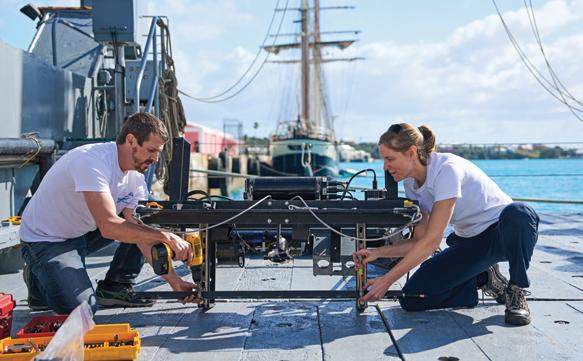

Though they might be small, the role plankton play is enormous.
“Zooplankton are the most abundant animals on Earth, by far, and they are sustaining all the trophic webs in the oceans,” Blanco-Bercial says.
They’re also the first step in the biological carbon pump, the crucial ocean system that sequesters carbon out of the atmosphere and stores it in the deep ocean.

The pump works like this: First, phytoplankton capture carbon dioxide through photosynthesis.
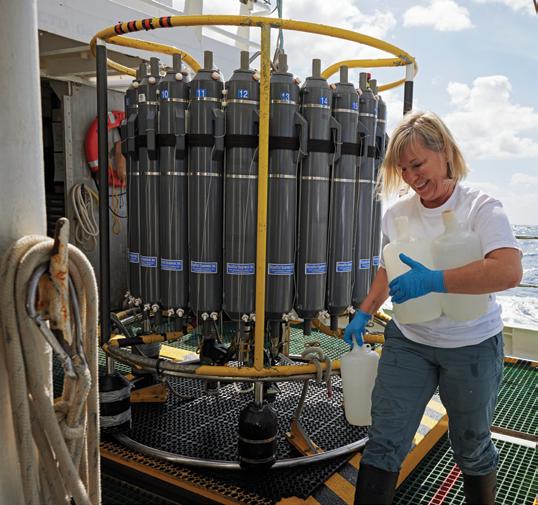
“Think of the equivalent of grass on land. That’s what phytoplankton are in the ocean,” says Susanne Neuer, founding director of the School of Ocean Futures and a professor in ocean biogeochemistry and one of Niimi’s advisors.
Then, the phytoplankton die and begin to sink, or they get eaten by zooplankton, which excrete fecal pellets containing organic carbon that sink even deeper. Those zooplankton die or get eaten by bigger predators themselves — and

“We need to know the crucial roles of these different zooplankton so that we know, as the ocean is changing, how the biological carbon pump may be changing.”
— SUSANNE NEUER, FOUNDING DIRECTOR OF THE SCHOOL OF OCEAN FUTURES
sink. As the organic carbon sinks and sinks, it gets stored for longer and longer. It can stay sequestered for up to 1,000 years if it reaches the deep ocean.
What Niimi, Neuer and others are trying to figure out is what zooplankton are out there, where they are going, how much they’re excreting and how much carbon or other nutrients are in all those sinking particles. After they collect the zooplankton, one experiment involves putting them in beakers and seeing just how many fecal pellets they produce and what’s in them. Understanding their vital roles in the carbon cycle is part of a puzzle.
because the seas are changing, already getting warmer and more acidic.
“We need to know the crucial roles of these different zooplankton so that we know, as the ocean is changing, how the biological carbon pump may be changing,” Neuer says, who is the principal investigator in the project.
Neuer started working with scientists at ASU BIOS about 15 years ago. ASU BIOS itself has been doing oceanography work for 120 years. U.S. scientists first visited it in 1903, and it has run long-term studies for years — like its Bermuda Atlantic Time-series Study, which has collected data on the ocean’s physical, biological and chemical properties through cruises out to sea every month since 1988. As Neuer and Niimi have done, other researchers can access that trove of historical data and piggyback onto those cruises for their work.
The oceans take up about a quarter to a third of all our emissions through this carbon pump. Without it, we would have already surpassed the 1.5 degree Celsius target from the Paris climate agreement, Neuer says.
“The ocean is buying us time,” Neuer says. And that time is thanks to plankton.
But while the ocean helps stem climate change, it’s being affected by it. The researchers are studying the biological carbon pump
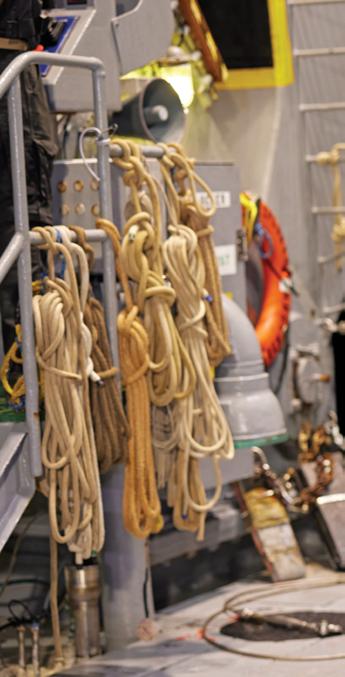

“That saves a lot of time, money and headaches, to know that those data exist,” Blanco-Bercial says, “and then you can focus on the question you want to answer.”
In 2021, ASU and BIOS joined forces, turning the Bermuda institution into a center for the Julie Ann Wrigley Global Futures Laboratory, alongside ASU’s Center for Global Discovery and Conservation Science in Hawaii.
“The merger between BIOS and ASU opens up ocean sciences for ASU students,” Neuer says, including opportunities for field experience and the chance to work with the faculty in Bermuda.
“They are the most abundant animals on Earth, by far, and they are sustaining all the trophic webs in the oceans.”
— LEOCADIO BLANCO-BERCIAL, ASSISTANT PROFESSOR
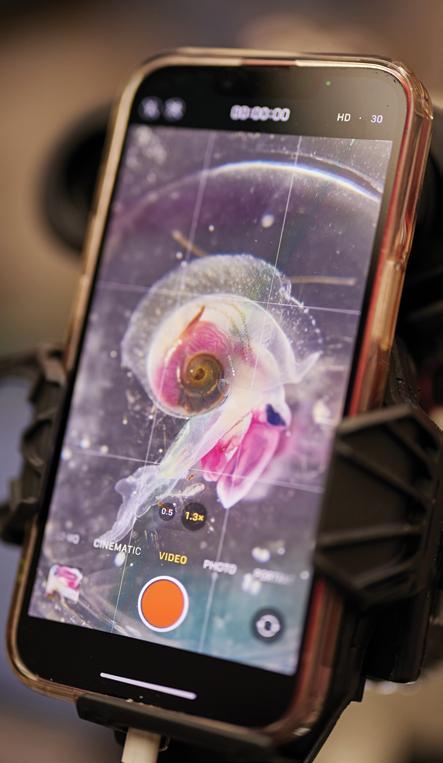



30% of the carbon dioxide produced by humans is absorbed by oceans, helping to buffer some of the effects of climate change
50%-80% of all Earth’s life lives under the ocean surface, and less than 10% of that space has been mapped, according to NOAA
50% of Earth’s oxygen is provided by oceans, more than the trees in the Amazon
1 billion people rely on oceans for their main source of protein
40 million jobs will be supported by the oceans by 2030
Andrea Brenner, a first-year PhD student in Neuer’s group who went on a research cruise with Niimi in the summer of 2022, and again in March 2023, has experienced the partnership’s benefit firsthand.

“I remember being on the ship and watching [Maas and Blanco-Bercial] empty the buckets attached to these nets, collecting these teeny tiny little things,” she says of her first cruise.
She watched them pick out these organisms without knowing what they were herself, learning on the go. But then, in their first class, Maas and Blanco-Bercial had more time to explain the types of plankton species and how they differ.
“It was very cool to see how I saw these species on a ship a couple of weeks ago, and now I’m learning about them in a classroom,” Brenner says.
ASU BIOS faculty are also aware of the difference having that connection to ASU’s campus can make. To William Curry, ASU BIOS president and CEO, bringing the ocean to ASU students, particularly through its online and hybrid programs, was a huge appeal.
“The online aspect and the flexibility of that kind of educational programming are really important when you’re on this little rock out in the middle of the North Atlantic,” Curry says.
Oceans cover over 70% of our planet. Their health irrevocably intertwines with Earth’s health. There’s much work to do to better understand the oceans and how climate change affects them.
One priority Curry has for ASU BIOS, in addition to the already extensive plankton research and
its decades-long time series research projects, is to increase its robotics operations. The institution already uses underwater gliders that take measurements using sensors, moving up and down the water column (and yes, sometimes they bump into marine life, even getting bitten by sharks). ASU BIOS has used these since 2014 to monitor the delivery of nutrients to the surface of the ocean, which limits and controls the surface productivity in the Sargasso Sea. One important discovery is the observation of a significant spring increase in turbulence caused by marine organisms, which increases nutrient delivery and biological productivity. Curry says it’s time to expand on taking more of the ocean’s vital signs with additional robotics.
“The future of observing the oceans is in autonomous robotics and sensor systems to provide continuous observations of important biogeochemical processes over broad areas of the
oceans, something that cannot be achieved by the few numbers of ships in the research fleet,” he says.
Beyond learning about the ocean, ASU also has the opportunity to help protect it — and our planet.
The Global Futures Laboratory focuses not just on research and education, Curry says, but on solutions. “[They’re] trying to figure out not just what will higher CO2 do to the planet, but how can we affect it or stop it or mitigate it better?”

Some answers, at least, likely lie underwater. ��
Watch videos and find out more: collegeofglobalfutures. asu.edu/school-of-oceanfutures
“The first time you bring up a net, everybody’s like, ‘What is that? That’s so weird!’ It looks like a busy city, but in three dimensions, or like a galaxy spinning around.”
— AMY MAAS, ASSISTANT PROFESSOR
Over the summer, several ASU FIDM students and alumni interned in New York City with leading fashion brands including ADTN International, Capri Holdings, Buffalo Exchange, Li & Fung with the brand Scoop and American Outfitters. Hands-on competitive internships are one of the program’s benefits that sets it apart.
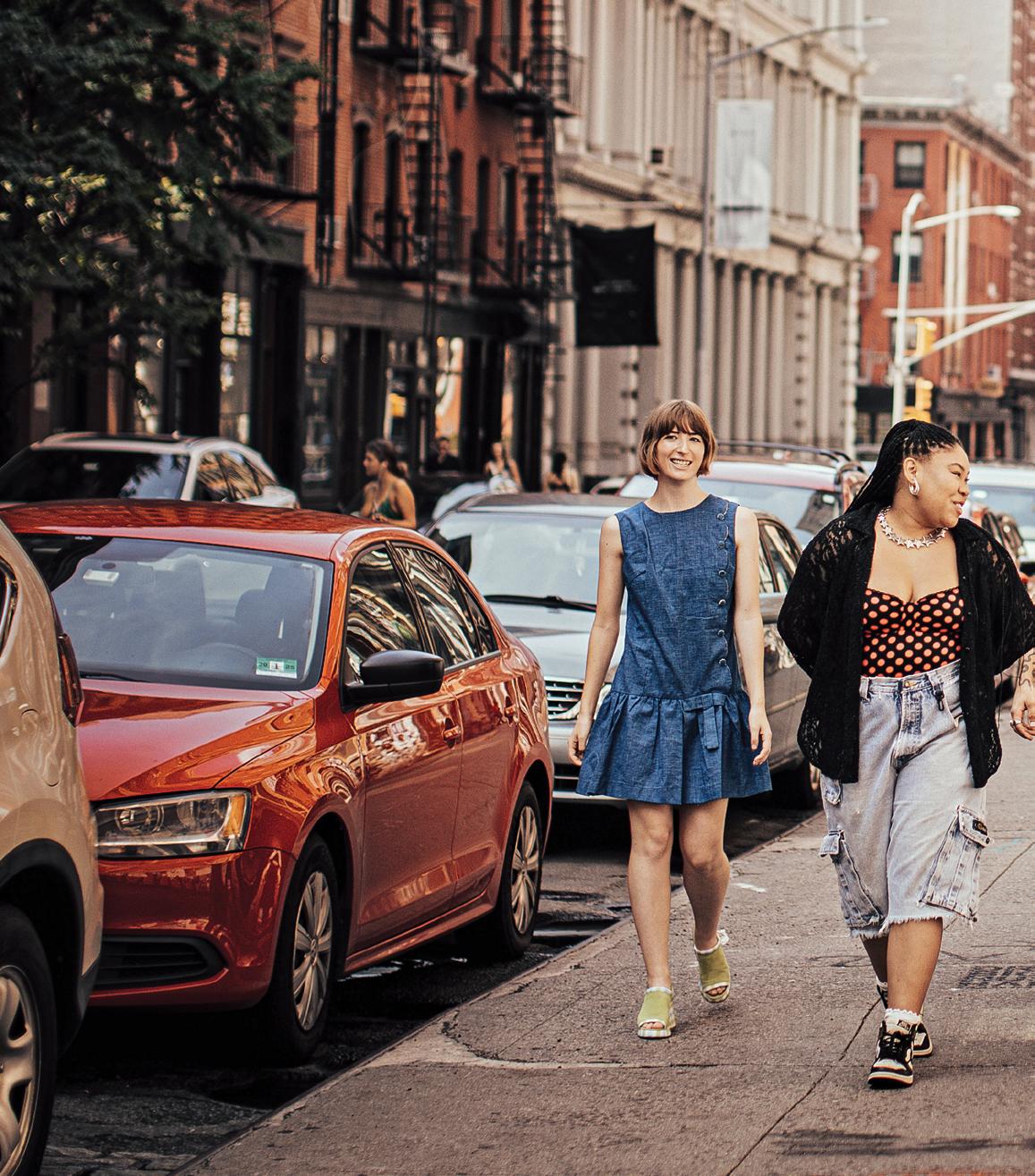
This fall, more than 450 students will learn as part of ASU FIDM.
The program, with locations in Los Angeles and Phoenix, offers a college experience with a world-renowned faculty. Students receive instruction with exceptional design, construction and wearable technology, studio spaces and an interdisciplinary makerspace with laser cutters, 3D printers, felting and industrial zero-waste knitting machines, and more.
Learn more about fashion at ASU at asufidm.asu.edu


An invention allows violinists to experience the music in their bodies and transforms the instrument
or years, violinist Seth Thorn, a clinical assistant professor in the School of Arts, Media and Engineering, wanted to expand how people play, learn and perform on instruments. Two years ago, he invented a device called an active shoulder rest to transmit the feel of
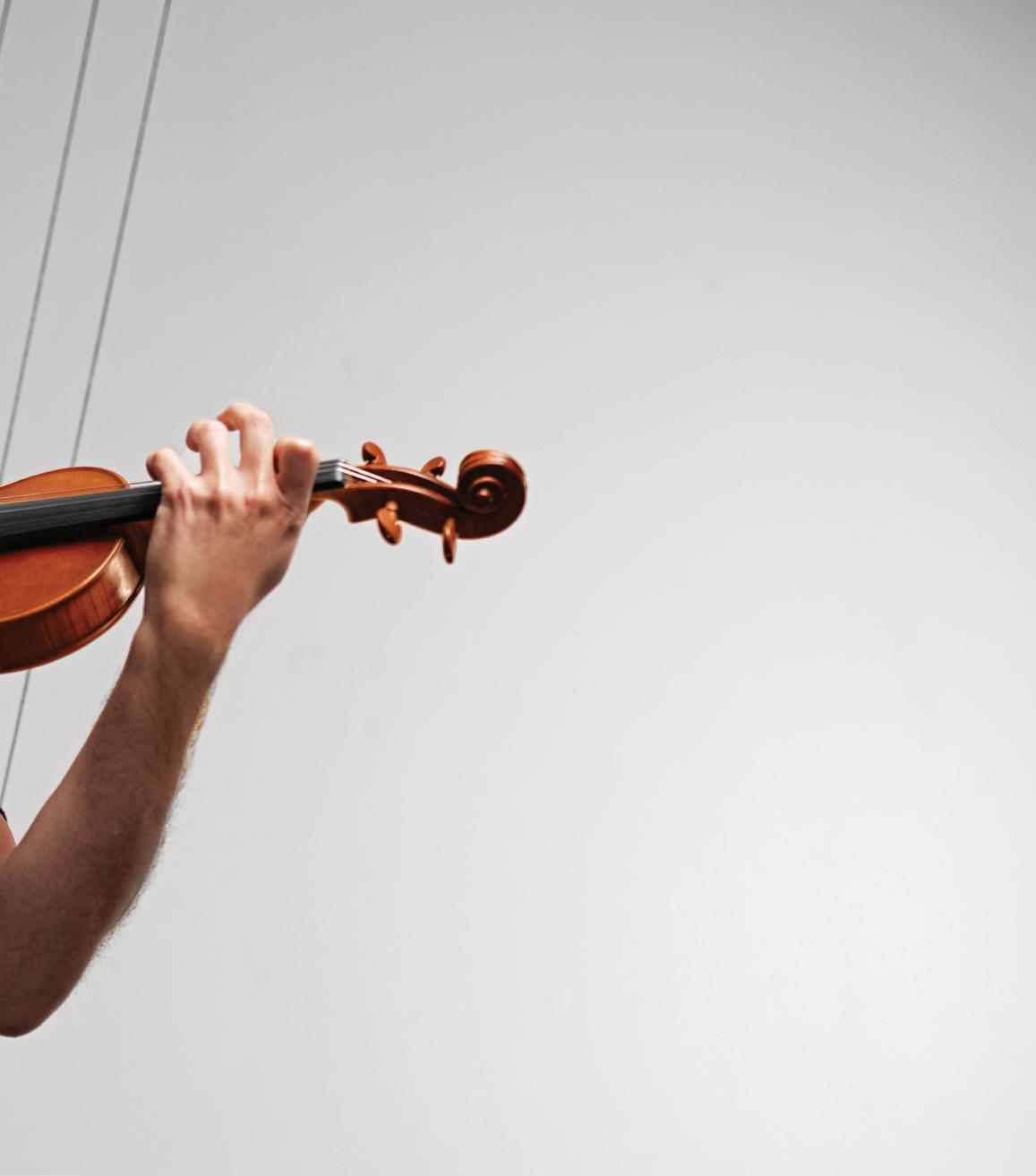
the violin’s sound to a player’s upper body. The revised version also includes small speakers.
“The speakers balance the sound,” Thorn says. “You get the vibration on your shoulder. You get the actuation of the violin in the upper body and the diffusion of sound more spatially.”
The active shoulder rest easily integrates into current violin playing because most violinists already use a shoulder rest to ease neck strain. A key feature is that it works with a violin’s traditional sound and strengths.

“Most of the haptic information you get with a violin is from the mechanoreceptors in your fingertips,” Thorn explains. “So adding haptic feedback felt by the collarbone and neck doesn’t disrupt those natural dynamics. It just adds feedback.”
worked with at Rosie’s House, when she plucks the violin and feels the sound, her eyes are just like, ‘Oh, my gosh!’” Thorn says.
Initially, Thorn made six active shoulder rests by hand with a colleague from the School of Arts, Media and Engineering. In 2022, he began sharing the active shoulder rests with Rosie’s House, a free musical academy for children in Phoenix. With a $10,000 seed grant from the Herberger Institute for Design and the Arts, the project is expanding and providing 3D-printed active shoulder rest devices, additional tools and music assistants from Thorn’s classes to more Valley schools.
The newest version of the active shoulder rest adds speakers. The various components enable digital musicians to add loops and background rhythms and then play music over them. Thorn compares the latest version of the shoulder rest to a combination of a guitar pedal and haptic device.
Thorn’s active shoulder rest serves as a silent metronome, allowing musicians experimenting with digital sound and people with sensory impairments or learning difficulties to entrain rhythm — in other words, to feel the music’s beat.
It also helps students more fully fall in love with the violin. In addition to learning scales and practicing sheet music, some students use it to expand into playing something they’ve heard by ear or to improvise, Thorn says.
“One of the students we
This technology gives players numerous ways to experiment. Thorn offers this anecdote: When a teacher and a student began using it for the first time, one of Thorn’s research assistants put on a repeating musical loop that the player both felt and heard through the violin.
“The student started. And I think the teacher was kind of sitting there, a little skeptical. Just like, what’s going to happen now. And the student started improvising a melody on top of the loop,” Thorn says. “And the
“ Most of the haptic information you get with a violin is from the mechanoreceptors in your fingertips. So adding haptic feedback felt by the collarbone and neck doesn’t disrupt those natural dynamics. It just adds feedback.”
— SETH THORN, CLINICAL ASSISTANT PROFESSOR
The active violin rest uses haptics so the performer can experience the sound in their body.
• ASU Skysong Innovations helped Thorn patent the device’s first version and the newest version. They advised on Thorn’s startup, Matter Squared LLC.
• Thorn completed a National Science Foundation Innovation Corps training in February at ASU, where entrepreneurs teach innovators to create a business strategy. The Innovation Advancement Legal Clinic at the Sandra Day O’Connor College of Law, which pairs inventors with ASU law students, also accepted Thorn.
• Thorn collaborated with Jerry Gintz, associate teaching professor, and faculty associate Travis Kelley, who both teach in the School of Manufacturing Systems and Networks on the Mesa campus. Gintz’s undergraduate class will prepare additive designs for manufacturing the shoulder rest version with Bluetooth speakers.
teacher started crying because it’s such an emotional thing in this classical music world to see that the student has another side, the ability to improvise.”
Thorn explains that the traditional way of learning the violin is to rehearse, perform in a recital and repeat. The active shoulder rest offers more ways to learn and grow.
“We’re bringing it to the ASU String Project next,” Thorn says.
The mission of the ASU School of Music, Dance and Theatre String Project is to offer low-cost, high-quality instruction on orchestral stringed instruments.

Soon, the newest version also will be Bluetooth-enabled, eliminating wires.
“The Bluetooth speaker will push the limits of the violin even more, creating a whole new instrument,” Thorn says.
How else does it make a difference? For composing music and performing, he adds.
“I picture something like a whole orchestra of them. And you’re adding a little magic and fairy dust, and people wonder, ‘What is that?’ I imagine the orchestra almost sparkling.” ��
Watch
See a performance by Seth Thorn at youtube.com/ arizonastateuniversity
Annual publication of circulation data per the USPS CAPS Cust. Ref. No. 278331 101 Prisma ASU Publication Title: ASU Thrive magazine Fall 2023 Vol 26, No 4 Publication Number: 1940-2929 Filing Date: 9-04-2023
Issue Frequency: Quarterly Number of Issues Published Annually: 4
Annual Subscription Price: $0.00 Complete Mailing Address of Publication: ASU Thrive, c/o Enterprise Brand Strategy and Management, P.O. Box 875011, Tempe, AZ 85287
Contact Person: Chris Myers
Complete Mailing Address of Headquarters: ASU Thrive, c/o Enterprise Brand Strategy and Management, P.O. Box 875011, Tempe, AZ 85287
Publisher: Jill Andrews, c/o Enterprise Brand Strategy and Management, P.O. Box 875011, Tempe, AZ 85287
Editor: Lindsay Kinkade,
c/o Enterprise Brand Strategy and Management, P.O. Box 875011, Tempe, AZ 85287
Managing Editor: Kari Redfield, c/o Enterprise Brand Strategy and Management, P.O. Box 875011, Tempe, AZ 85287
Owner: Arizona State University Enterprise Brand Strategy and Management, P.O. Box 875011, Tempe, AZ 85287

Known bondholders, Mortgages, Security Holders Owning: None
Tax Status: Has not changed during the preceding 12 months
Issue Date for Circulation Data Below: September 2023
Extent and Nature of Circulation: Total Number of Copies: Average per issue
Printed: 562817 / 589516
Mailed outside-county paid subscriptions: 546442 / 572875
Mailed in-county paid subscriptions: 0 / 0 Sales Through Dealers and Carriers, Street Vendors, Counter Sales, and Other Paid or Requested: 0/0
563087/ 590595
Paid and/or Requested Circulation: 97.0 / 97.1
and Paid Electronic Copies: 0 /
Requested and Paid Print Copies + Requested / Paid Electronic Copies: 546442 / 572875
Requested Copy Distributed + Requested / Paid Electronic Copies: 546442 / 572875 Percent Paid and/or Requested Circulation: 97.0 / 97.1
This Statement of Ownership will be printed in the September 2023 issue of this publication.
I certify that the statements by me above are correct and complete: s/Jill Andrews, Publisher, 9/01/2023
Many people trace the origin of hip-hop to a house party in the Bronx on Aug. 11, 1973, when a DJ played just the instrumental parts of the songs – the “breaks” – while rhyming on the microphone. From there, hip-hop grew into an entire culture of music, dance, fashion, art and identity.
Jorge “House” Magana, a clinical assistant professor in the School of Music, Dance and Theatre who teaches a hip-hop dance and history class, reflects back to his earliest days practicing and helping develop the art form. Before the internet and MTV, break dancers hungered to see new moves and up their game, he says.
“So you could literally be at home and somebody would give you a phone call and be like, ‘Yo, there’s somebody breaking at Dairy Queen,’” he says. “And you would run out there and be like, ‘You break, cool, let’s battle!’”
Starting in 2024, the sports form of hip-hop dance — break dance — debuts as an Olympic event. musicdancetheatre.asu.edu

“My mom would say, ‘You’re just rolling around on the floor.’ But it’s very intricate patterns.”
— HIP-HOP PIONEER JORGE MAGANA, WHOSE STAGE WORK INCLUDES A 29-CITY TOUR IN JAPAN AND REPRESENTING TEAM USA IN RED BULL LONDON “BEAT BATTLE”
Gold medalist Léon Marchand gets kudos from Michael Phelps for winning the Men’s 400-meter individual medley final and setting a new world record.
By the time he turned 18, Léon Marchand demonstrated world-class swimming abilities. He already had competed in the 2020 Olympics, with a best finish of sixth in the 400-meter individual medley.
To further his swimming abilities and pursue his education, Marchand chose ASU. The reason? ASU’s Bob Bowman had coached world-champion swimmer Michael Phelps.
Now, Marchand, a 21-year-old junior and computer science major, is setting records as a Sun Devil. He won six medals – including three gold – at the 2023 NCAA Division I Men’s Swimming Championships earlier this year.
Then, at the World Aquatics Championships in July, he won the gold in the 200 fly, the 200 IM and the 400 IM. How fast was he? He beat Phelps’ 20-year-old world record in the 400 IM.

He’s expected to break more records in the 2024 Summer Olympics in France. But before then, there’s one other goal: to help ASU finish first in the NCAA Men’s Swimming and Diving Championships this season.
“I know we can do better,” he says. “I know we can win. And I want to be a part of it.”
Learn more at thesundevils.com
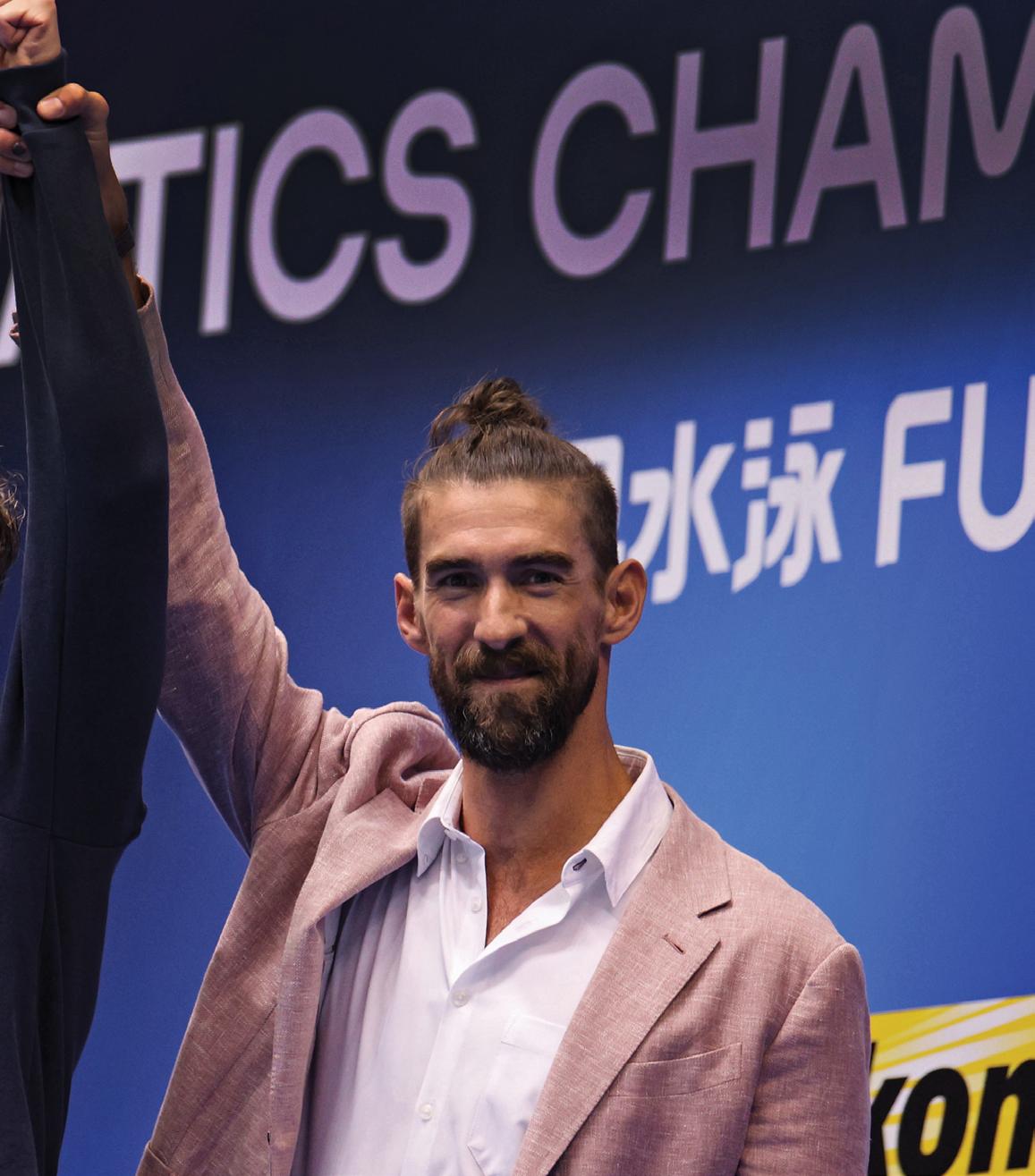

Two-time Sun Devil Softball national champion Brittney Matta, ’11 BS in criminology and criminal justice and ’22 MEd in higher and postsecondary education, led the South Mountain Community College softball team to wins.
In 2023, the Cougars advanced in the Arizona Community College Athletic Conference to claim the Region I Division II Tournament Championship and competed in the NJCAA Division II World Series. Five Cougars earned All-ACCAC and All-Region I Division II honors. SMCC’s Makaiya Gomez won the ACCAC Player of the Year, and Matta was named ACCAC Coach of the Year.
Turner Washington won the discus in dramatic fashion at the NCAA Championships, collecting his fifth total national title and his second discus crown.
Sun Devil Track and Field had an NCAA Championships to remember, with the teams earning nine All-American honors and taking home medals. Turner Washington, ’20 BS biological sciences, became a five-time national champion going out on top by winning the discus, collecting his fifth total national title and ninth All-America honor on the final throw of the event. Senior pole vaulter Sevanna Hanson

came in fourth place overall and finished as an All-American. The Men’s Track and Field team beat program records in the 4x100 and 4x400 relays and nearly beat the 4x4 NCAA record. Senior high jumper Grace Campbell tied her No. 3 all-time mark for a ninthplace finish and earned Second Team All-American.
Learn more at thesundevils.com
Former softball champ Brittney Matta (center in white) with her community college team.By the numbers: Sun Devil Athletes
Academics 2022–23
11 Number of athletes who won College Sports Communicators Academic All-America honors this year, a university record
132 Number of student-athletes who achieved a 4.0 semester or cumulative GPA
134 Sun Devil student-athletes who earned their degrees in 2022–23
79% Percentage of Scholar Athletes with a GPA at least 3.0 as of 2021–22
Five-time NCAA Champion Turner Washington earned his third consecutive Academic All-American Team Member of the Year award with a perfect 4.0 GPA as an undergrad and a 3.8 GPA as a graduate student in the sports, law and business program.
It’s possible to predict a professional e-player’s drop in performance 20 minutes before it occurs using biometric data, according to an ongoing study at the adidas-ASU Center for Engagement Science in collaboration with gamer company HyperX.
The next steps will study how to intervene early. The team hopes that the ability to head off screen fatigue can be applied to other fields, from aerospace engineers to radiologists.
“The results are broadly applicable, especially if we’re talking about workplace performance,” says Aurel Coza, director of the center. “Most jobs involve staring at a screen for hours a day. That’s not much different, honestly, than any video game.”
Read more at corporate.asu.edu/ adidas
Sun Devil Women's Golf standout Linn Grant is the 2023 Dana Open Champion, capturing her first career LPGA Tour victory. The two-time All-American becomes the latest product of Sun Devil Women's Golf to win at the sport's highest level. Grant put together one of the most decorated two-year careers in the history of the program while at ASU, and her success has continued as a professional. Grant was not the only Sun Devil who enjoyed success at the Dana Open. Both Carlota Ciganda (T12th) and Linnea Strom (T15th) put together strong efforts that yielded them a Top-20 finish. And with Grant’s victory, she collects $262,500, adding to the over $40 million of total earnings from Sun Devils on the LPGA Tour.

Calling all space fans: This October, the first ASU-led deep-space mission is set to launch from Kennedy Space Center. Principal investigator and ASU Regents Professor Lindy Elkins-Tanton is leading the mission, a journey to a metal-rich asteroid called Psyche that offers a unique window into the building blocks of planet formation. Watch the launch online at 10:38 a.m. EST on Thursday, Oct. 5; the NASA preshow starts about 40 minutes ahead of the launch, at 10 a.m. EST, so log on and learn all about this exciting mission.
Explore more at psyche.asu.edu/mission/launch
Artists rendering of the spacecraft near the Psyche asteroid, which is likely made mostly of metal.


